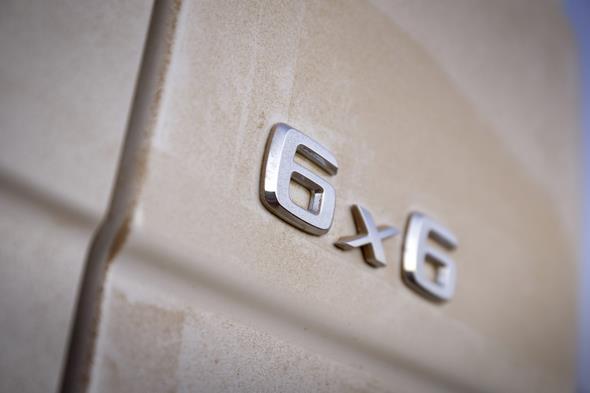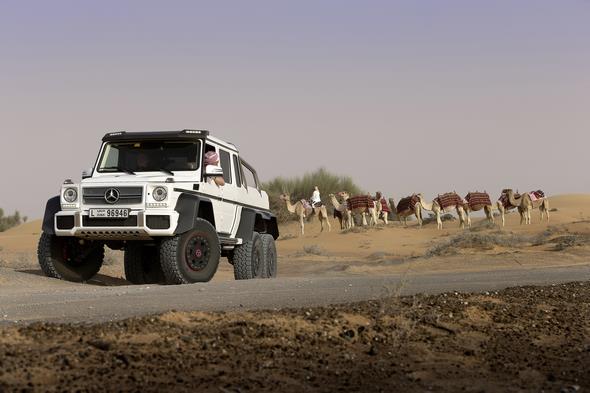Mercedes W460, 461, 462, 463 G-Class Geländewagen 1979 –


Mercedes-Benz G-Class: Legendary Off-Roader will remain part of the Mercedes product lineup
- DaimlerChrysler to continue successful and long-standing cooperation with Magna Steyr in Graz, Austria
- Customer demand remains at a high level in Germany and abroad
- All E-Class variants to be produced at the DaimlerChrysler plant in Sindelfingen from 2007
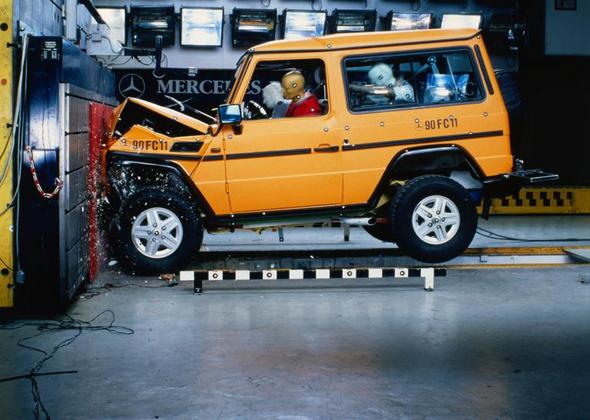


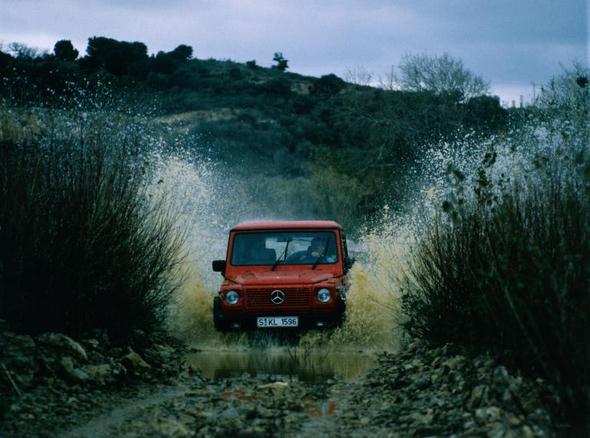
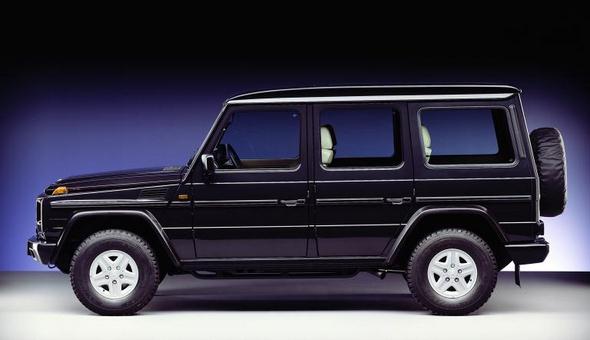
Forever young
Mercedes-Benz has once again significantly upgraded the G-Class, so reemphasising its position as the leader among off-road vehicles.
The interior is characterised by high-quality appointments finished with exquisite materials.
The instrument cluster and centre console have been completely redesigned. The driver’s field of vision now encompasses a colour screen, between two new round dials.
The car features as standard the sophisticated COMAND Online infotainment system, including a navigation system and internet access.
New LED daytime driving lamps and new exterior mirrors bring a few discreet changes to the appearance of the luxury off-roader.
The range of safety equipment can be optionally enhanced with the addition of Blind Spot Assist, the parking aid PARKTRONIC and the adaptive cruise control system DISTRONIC PLUS.
New to the range are the G 63 AMG with an eight-cylinder biturbo engine and the ECO start/stop system as standard, and the G 65 AMG with twelve-cylinder biturbo engine.

Since it was originally conceived in 1979, as a vehicle to be used primarily in tough off-road terrain, the G-Class has undergone an astounding process of evolution.
Over the course of 33 years Mercedes-Benz has refined what was initially a very practically-oriented off-road specialist by giving it a high-class interior and road-going qualities on a par with those of the premium saloons emanating from Stuttgart.
The G-Class today is considered the top model among luxury-class cross-country vehicles, and has provided the gene pool for the other very successful SUVs built under the Mercedes-Benz brand.
The G-Class has been voted off-roader of the year countless times over the past years – as also once again this year.

A comprehensive range of measures ensures that this classic cross-country vehicle remains in a class of its own in the off-road sector.
These measures include new engines, a significantly extended range of appointments, a new, even more luxurious interior and a few discreet external modifications that nevertheless manage to preserve the timeless, classic design – virtually unchanged since 1979 – that has made the G-Class a true automotive style icon.
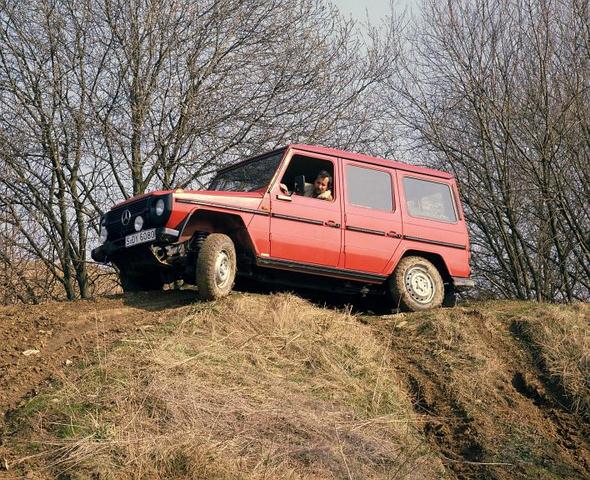
Dr Dieter Zetsche, Chairman of the Board of Management of Daimler AG and Head of Mercedes-Benz Cars: “Our G-Class has been a force to be reckoned with for the last 33 years.
In its latest evolutionary stage, it offers state-of-the-art, powerful engines, a further improved range of luxurious appointments and the very latest safety features, as well, of course, as its now legendary off-road capabilities.
At the same time the design remains true to its down-to-earth, unmistakable style.”

Discreet exterior modifications, a complete new look inside
The external modifications include LED daytime running lamps and new exterior mirrors for all engine variants. The AMG versions also feature a new, characteristic AMG radiator grille with double louvres, plus distinctive new bumpers with large air intakes.
Red brake callipers and 20-inch wheels, available here for the first time, complement the emotive appeal of its exterior.
The instrument panel and centre console have been completely redesigned to include new controls and generously proportioned, exclusively designed trim elements.
These give the interior of the car a fresh and classy look. Drivers will now find a TFT colour display in the instrument cluster between the two round dials.
A further large colour screen, conveniently positioned in the centre, is part of the COMAND Online system and incorporates a DVD changer and the COMAND Controller, which are standard on all G-Class models.
This new infotainment generation offers, amongst other features, internet access, a navigation system with special additional off-road functions, the LINGUATRONIC voice-operated control system and Bluetooth wireless connectivity.
In order to ensure that the G-Class nevertheless does not lose any of its character, certain specific design elements in the interior have been preserved.
The G-Class thus retains the grab handle on the front-passenger side, the switches for the three differential locks – clearly aligned within the driver’s field of vision and highlighted in silver-coloured trim – and the redesigned shift lever in the lower section of the centre console.

New optional extras include safety features such as DISTRONIC PLUS, Blind Spot Assist and the parking aid PARKTRONIC with reversing camera. The ESP® system has been completely revised and now includes Trailer Stability Assist and a HOLD function.
Further individualisation options from the exclusive designo range are available as enhancements to what is already a very high-quality interior package.

Sophisticated engines with high power reserves
The range of engines in the G-Class includes the G 350 BlueTEC and the G 500, both as a long-wheelbase Station Wagon, plus the G 500 as a short-wheelbase Cabriolet model.
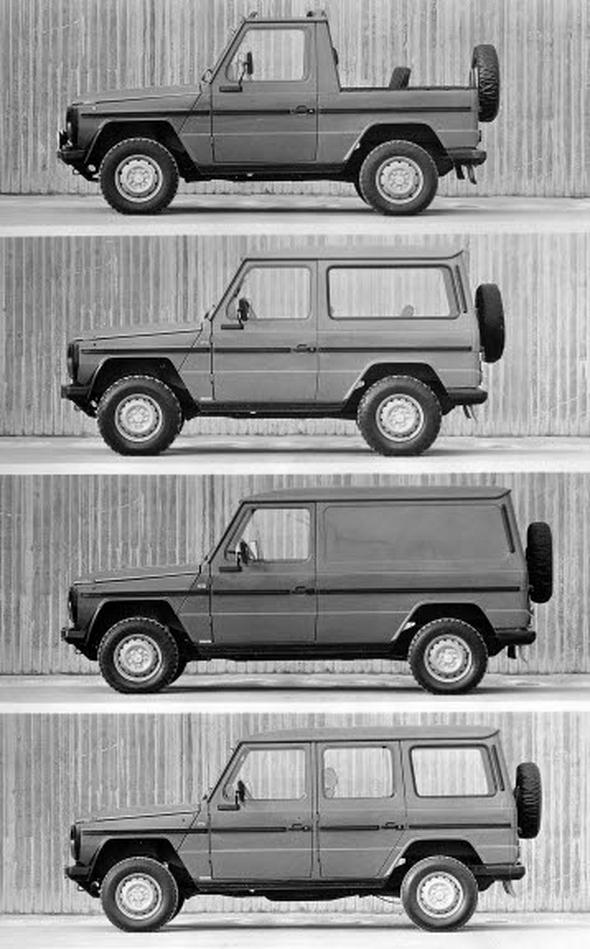
The basic version of the long-wheelbase Station Wagon model is the G 350 BlueTEC with V6 diesel engine and a displacement of 2987 cc.
The four-valve engine has an output of 155 kW (211 hp) at 3400 rpm and has available torque of 540 Newton metres across an engine speed range of 1600 to 2400 rpm.

The BlueTEC technology developed by Mercedes-Benz minimises its emissions, in particular of nitrogen oxides (NOx). The G 350 BlueTEC works to even better effect thanks to the addition of AdBlue®, an aqueous urea solution that is injected into the flow of exhaust gases. Refilling with AdBlue® is conveniently done from the outside of the vehicle.
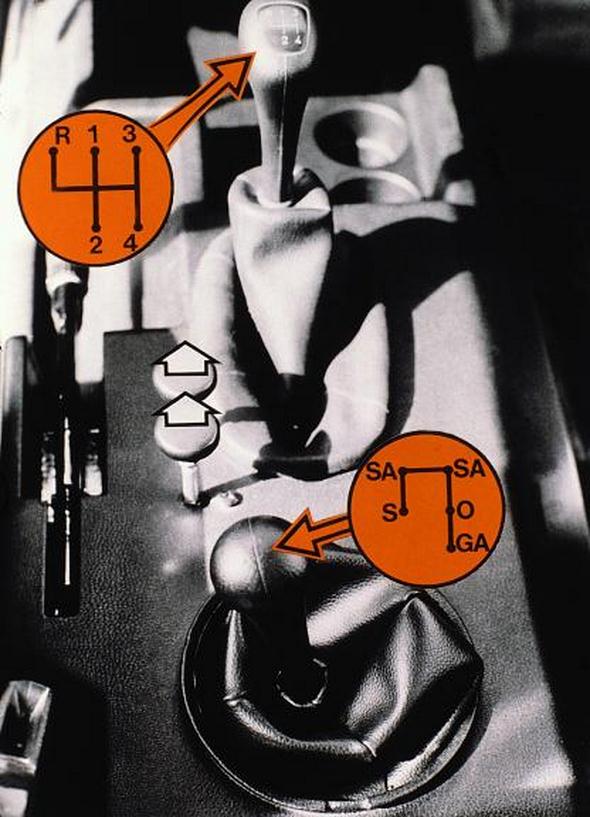
One alternative to the diesel engine is the G 500, with its powerful 5.5-litre V8 petrol engine. This has an output of 285 kW (387 hp) and offers excellent torque of 530 Newton metres.
The same engine also ensures that the G 500 Cabriolet has generous reserves of power to deal with any situation.

Both the G 350 and the G 500 feature the 7G-TRONIC PLUS automatic transmission as standard. Now in its sixth generation, the multi-ratio automatic transmission was developed by Mercedes-Benz and has been produced since 1960.
The new version has been thoroughly revised to optimise consumption and comfort compared with its predecessor.

New to the range are the G 63 AMG with V8 biturbo engine (400 kW/544 hp and 760 Nm of torque), which features the ECO start/stop system as standard, and the G 65 AMG with V12 biturbo engine (450 kW/612 hp and 1000 Nm of torque), which makes this the most powerful series-produced cross-country vehicle in the world.

Superior off-roader
The technical qualities of the G-Class continue to be highly prized. The tremendous torque of its engines makes the luxury off-roader an excellent vehicle for towing, while its three electrically controlled 100-percent differential locks, ladder frame and rigid axle are characteristics that make it an unrivalled proposition in rough, off-road terrain.

The market launch of the new-generation G-Class will be from June 2012.
Prices at a glance (for the German market, incl. 19% VAT):
G 350 BlueTEC
G 500
G 500 Cabriolet
G 63 AMG
G 65 AMG
Mercedes-Benz G 63 AMG and G 65 AMG
G-Class Summit
High tech for the AMG off-road classic: the new G 63 AMG impresses with state-of-the-art drive technology, expressive design and increased fuel economy.
All this is largely attributable to the AMG 5.5‑litre V8 biturbo engine delivering 400 kW (544 hp) and the AMG SPEEDSHIFT PLUS 7G TRONIC automatic transmission system.

Even more exclusive is the new G 65 AMG: its AMG 6.0-litre V12 biturbo engine delivers 450 kW (612 hp) and reaches a maximum torque of 1000 newton metres – a record in the off-road segment.
Every new AMG high-performance vehicle offers an outstanding mix of “more power from less fuel” – and the G 63 AMG is no exception.
The “strong man” in the AMG model range has been further enhanced with the state-of-the-art powertrain of the new ML 63 AMG.

The design has been comprehensively reworked, so that, for the first time in the 33-year history of the G-Class, AMG customers can enjoy a raft of future-oriented systems: spray-controlled petrol direct injection, the ECO start/stop function and generator management.
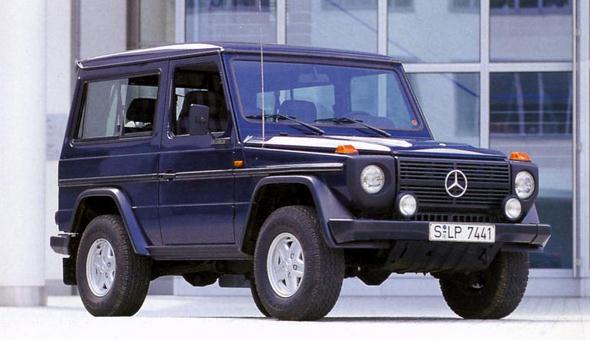
The AMG 5.5-litre V8 biturbo engine develops a maximum output of 400 kW (544 hp) and a torque of 760 newton metres. This enables the new G 63 AMG to accelerate from zero to 100 km/h in just 5.4 seconds, with a new top speed of 210 km/h (electronically limited).
The new G 63 AMG outperforms the G 55 AMG KOMPRESSOR by 27 kW (37 hp) and 60 newton metres. Its direct predecessor was a clear favourite for G-Class purchasers, with a sales ratio of over 40 percent.
Key figures for the G 63 AMG at a glance:
| G 63 AMG | |
| Displacement | 5461 cc |
| Bore x stroke | 98.0 x 90.5 mm |
| Compression ratio | 10.0 : 1 |
| Output | 400 kW (544 hp) at 5500 rpm |
| Max. torque | 760 Nm at 2000–5000 rpm* |
| Fuel consumption, NEDC combined | 13.8 l/100 km |
| CO2 emissions | 322 g/km |
| Efficiency class | G |
| Acceleration 0–100 km/h | 5.4 |
| Top speed | 210 km/h* |
* electronically limited
AMG SPEEDSHIFT PLUS 7G-TRONIC and ECO start/stop function
The vehicle’s driving performance features are matched by its impressive advances in the area of fuel economy. The fuel consumption of 13.8 litres per 100 kilometres (NEDC combined) is a reduction of 2.1 litres on the predecessor model, representing fuel savings of 13 percent.
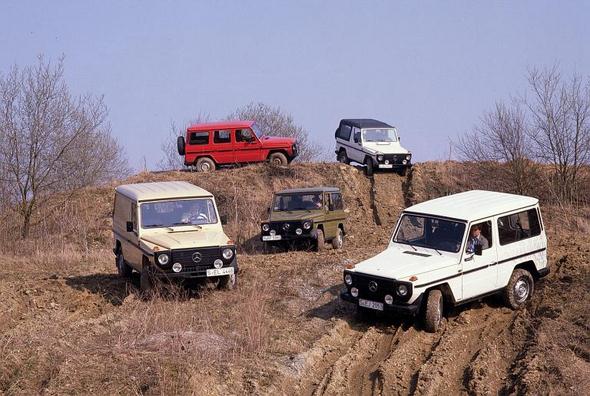
This reduction can be attributed to the state-of-the-art biturbo eight-cylinder engine, along with the AMG SPEEDSHIFT PLUS 7G-TRONIC automatic transmission system, the generator management system and the ECO start/stop function.
The seven-speed automatic gearbox features three drive modes and an automatic double-declutching function for downshifting, creating an incredible range of variability.
In “Controlled Efficiency” (C) mode, the ECO start/stop function is active, shutting down the eight-cylinder engine when the vehicle is stationary.
“C” mode is also characterised by smooth accelerator and transmission characteristics and early gear changes; the vehicle is usually started in second gear in this mode.
The AMG instrument cluster includes a green “ECO” symbol, indicating when the ECO start/stop function is on.

In the Sport (S) and Manual (M) modes, the ECO start/stop function is off, and the engine-transmission combination displays far greater agility.
Short, precisely defined ignition and injection retardations mean shorter shift times when changing up at full load.
The efficiency of the AMG SPEEDSHIFT PLUS 7G-TRONIC automatic transmission system is further enhanced with a new fuel economy converter with centrifugal pendulum, friction-reducing bearing and transmission oil thermal management.
The fascination of the characteristic sound of a V8 AMG
A glance at the AMG sports exhaust system will reassure any doubters that all these efficiency advances have not been at the expense of emotional appeal.
The twin tailpipes on both sides at the rear put out the hallmark AMG eight-cylinder sound that means so much to the vehicle’s many admirers.

The latest catalytic converter technology is used to ensure that the G 63 AMG meets both the EU 5 exhaust emissions standard and the requirements for the US market (LEV-II standard, on-board diagnosis II and lambda probe diagnosis).
New chassis settings, optimised acoustic comfort
The suspension/damper settings in the AMG Sports chassis have been adjusted for the more dynamic handling characteristics of the new model.
To reduce vibration and noise impacts, the design engineers at Mercedes-AMG have also implemented a wide range of NVH (noise, vibration, harshness) measures.
Optimised bearings for the automatic gearbox, transfer case and engine cut vibration and noise levels. All this ensures a more comfortable ride and helps to keep the driver fit and alert, particularly over long distances.

The wheels and brakes are also completely new. The G 63 AMG runs on new AMG 5×2 spoke light alloy wheels as standard equipment.
The 9.5 x 20 titanium-grey-painted wheels with high-sheen finish are fitted with 275/50 R 20 tyres. As an exclusive special equipment option, the vehicle can be fitted with matt-black-painted AMG light alloy wheels with high-sheen rim flanges.
The new AMG high-performance brakes deliver top performance in terms of deceleration, adjustable feed and endurance.
All-round ventilated, perforated brake discs with dimensions of 375 x 36 millimetres at the front and 330 x 20 millimetres at the rear provide optimum thermal capability and outstanding deceleration values.
The front axle is fitted with a six-piston fixed-calliper brake system taken from the ML 63 AMG, with a single-piston floating-calliper system on the rear axle.
The brake callipers are painted red around the entire circumference, and are also available in silver.
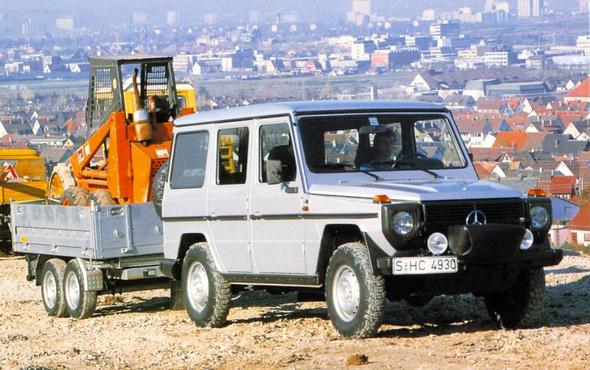
Fully readjusted ESP® for with more comfort functions
The new generation of the G-Class also offers a range of exemplary safety features. For example, the luxury off-roader has a completely readjusted ESP®, with automatic control systems including the start-up assist and a HOLD function, both for easier hill starts.
And in an emergency braking situation, when the driver suddenly releases the accelerator and hits the brake pedal, the brake system increases the pressure in the brake lines and applies the brake linings to the discs.
This ensures maximum effect as soon as the brake is applied. This “pre-filling” function supports the brake assist fitted as standard.
For customers ordering the optional trailer coupling, the ESP® trailer stabilisation feature provides increased safety when the vehicle is pulling a trailer.
This additional ESP® function detects the trailer as soon as the electric connector plug is inserted in the socket on the towing vehicle.

The ESP® trailer stabilisation system uses the sensors of the ESP®, counteracting any fishtailing of the trailer at speeds higher than 65 km/h by alternating brake application to the left and right front wheels.
This is generally sufficient to eliminate the problem and prevent any further risk.
In very severe fishtailing situations, the engine torque is also reduced and the towing vehicle is braked on all four wheels, to get the vehicle back to within a safe speed range as quickly as possible.
Characteristic AMG styling with the new face of the brand
The appearance of the eight-cylinder top-of-the-range model is also definitely up with the times. Following the example of the SL 63 AMG and SL 65 AMG, the G 63 AMG has also taken on the new face of the AMG brand.
The high-gloss black “twin-blade” radiator grille with four chrome inserts makes the new G-Class model instantly recognisable as an AMG.
The grille design is consistent with the car’s classic contours, with an off-road look perfectly integrated into the vehicle’s overall appearance.
Another completely new feature is the AMG bumper, with three generously dimensioned openings as airflow inlets for the cooling module.
Vertical high-gloss chrome stainless steel inserts create a distinctively masculine look for the G 63 AMG. New LED daytime running lamps are fitted below the bi-xenon headlamps.

As before, only the AMG model has the characteristic wheel-arch flares, stainless-steel running boards and side protective strips with stainless-steel inserts.
Other distinctive features include the “V8 BITURBO” logo on the front mudguard and G 63 AMG type plate on the rear door.

Stylish new-look interior with increased comfort
The interior features even more innovations in comparison with the predecessor model. Along with the facelift changes provided as standard, including the new instrument panel and state-of-the-art infotainment and assist systems, the G 63 AMG has an AMG instrument cluster with colour TFT screen, AMG main menu and separate gear display, plus white-lit AMG sills on all doors.
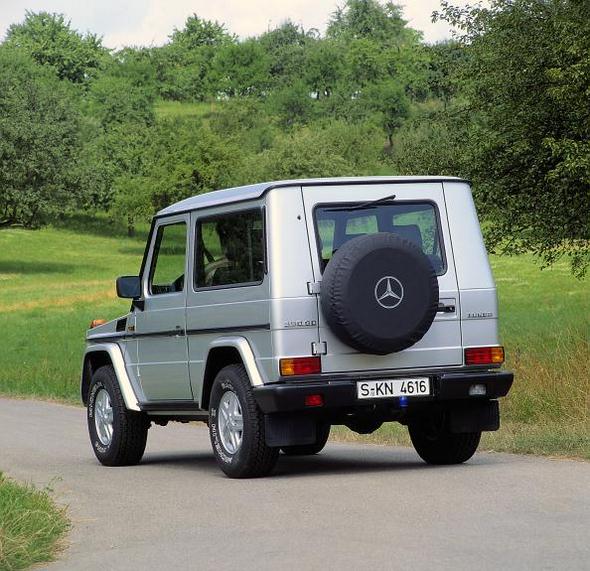
The classy E-SELECT shift lever with the distinctive AMG medallion is a familiar feature from other models such as the SLS AMG.
An exclusive on-board environment is created by the designo leather upholstery with ruffled leather door panelling. Options available for an even more stylish interior comprise the AMG carbon trim and the designo Exclusive package.
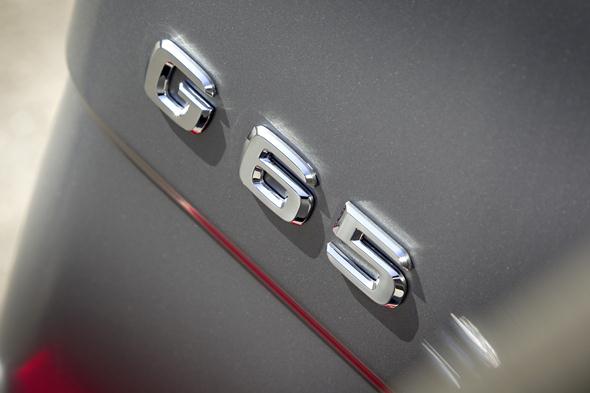
Exclusive twelve-cylinder performance: the new G 65 AMG
Even more exclusive, and also the world’s most powerful production off-road vehicle, is the new G 65 AMG.
With maximum output of 450 kW (612 hp) and maximum torque of 1000 newton metres, the top-of-the-range V12 model delights the connoisseur with its incomparably dynamic handling characteristics.

The G 65 AMG accelerates from zero to 100 km/h in just 5.3 seconds, and has a top speed of 230 km/h (electronically limited).
This is the first G-Class vehicle to be equipped with the AMG 6.0-litre V12 biturbo engine, which features new exhaust turbochargers with increased spiral cross-section, flow-optimised wastegate channels, multi-spark ignition with twelve double-ignition coils and a higher-power engine control unit.
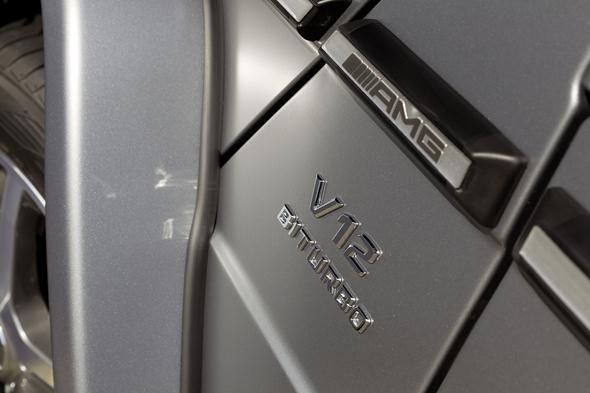
The result is enhanced combustion, leading to smoother running and power delivery. The high-quality carbon and aluminium engine cover adds a final visual touch to this extensive package of new features.
As in the G 63 AMG, the AMG SPEEDSHIFT PLUS 7G‑TRONIC automatic transmission system is responsible for power transmission to all four wheels.

The key data at a glance:
| G 65 AMG | |
| Displacement | 5980 cc |
| Bore x stroke | 82.6 x 93.0 mm |
| Compression ratio | 9.0:1 |
| Output | 450 kW (612 hp) at 4300–5600 rpm |
| Max. torque | 1000 Nm at 2300–4300 rpm* |
| Fuel consumption, NEDC combined | 17.0 l/100 km |
| CO2 emissions | 397 g/km |
| Efficiency class | G |
| Acceleration 0–100 km/h | 5.3 |
| Top speed | 230 km/h* |
* electronically limited
In terms of appearance, the G 65 AMG is differentiated from its V8 sister model by the high-gloss chrome radiator grille, the 9.5 x 20 AMG five-spoke light alloy wheels, painted titanium grey with high-sheen finish, its 275/50 R 20 tyres and the V12 BITURBO logo on the mudguards.
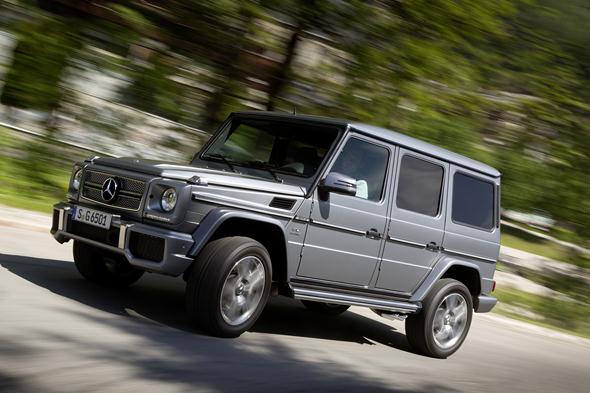
Interior features include the welcome display with exclusive AMG V12 BITURBO animation, the designo leather exclusive upholstery and the leather instrument panel trim.
A unique special touch is the distinctively V12 diamond design of the seats, including the impressed AMG medallion on the headrests.

This distinctive upholstery feature is repeated on the door central panels. A comprehensive range of standard equipment includes black piano lacquer designo trim features and designo foot mats.
An exclusive special option from the AMG Performance Studio is AMG light alloy wheels, painted matt black with high-sheen rim flanges.
Prices in Germany at a glance (including 19% VAT):
G 63 AMG 137,504.50 euros
G 65 AMG 264,180 euros
Both AMG models are available only in the station-wagon long version.
Market launch is as from June 2012.
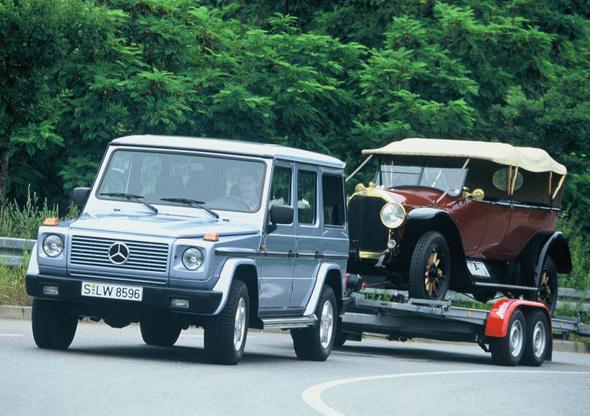
The AMG G-Class: unmistakeable by tradition
The G 55 AMG KOMPPRESSOR has been a favourite since 2004, as a strong character, immune to passing fashions.
The AMG 5.5-litre V8 supercharged engine initially developed 350 kW (476 hp), increasing to 368 kW (500 hp) in 2006 and 373 kW (507 hp) in 2009.

The maximum torque of 700 newton metres remained unchanged, along with the vehicle’s supremely dynamic performance values.
The G 55 AMG KOMPRESSOR accelerated from zero to 100/km in 5.5 seconds, with a top speed of 210 km/h (electronically limited).
The new-generation Mercedes-Benz G-Class
The evolution of an icon: the original off‑roader is now even better, even safer and even more luxurious
- Exclusive high-grade appointments
- New AMG biturbo engines
- Its unmistakable style puts it in a class of its own
After 33 years the Mercedes-Benz G-Class once again has fresh momentum behind it, as the sales figures for this most enduring of luxury off-roaders go to show. Between 2009 and 2001 sales rose by more than 50 percent.
A comprehensive facelift is now set to make this classic among cross-country vehicles an even more attractive proposition.

With a new and luxurious interior, some discreet modifications to the exterior, new safety features, a new infotainment system and, in some cases, new engines, Mercedes-Benz has upgraded the award-winning G-Class even further in a continuation of its remarkable evolution.

The G-Class was originally conceived as a vehicle for use primarily in tough, off-road terrain; and this was the way it was launched, back in 1979.
Over the course of its long years of production, the specification has been regularly modified to reflect the requirements of its customers – but the essential character of the G-Class remains unchanged.

Over the years, state-of-the-art electronics have been applied to improving its already outstanding off-road capability still further.
At the same time Mercedes-Benz has continued to work on bringing the interior appointments and road-going qualities up to the same high standard as for the premium saloons emanating from Stuttgart.
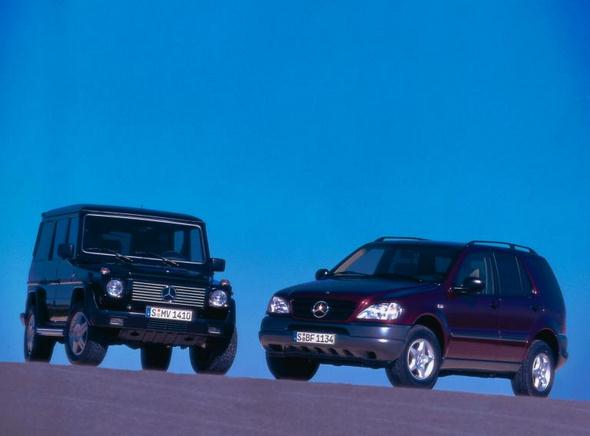
Its outstanding performance in tough terrain, its ability as a towing vehicle and its luxurious look and feel have all added up to ensure that the G-Class is still going strong after what is now a third of a century.
Even today, this classic model is still considered one of the best cross-country vehicles around and has only recently once again been voted “Off-roader of the year” – after 33 years on the market.
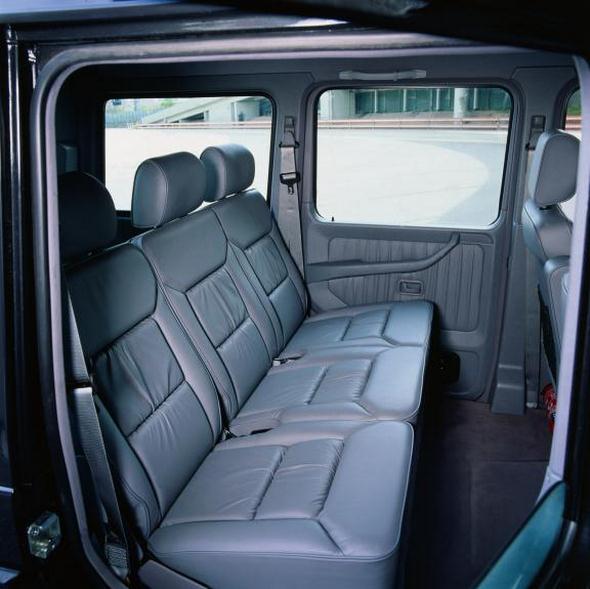
Dr Dieter Zetsche, Chairman of the Board of Management of Daimler AG and Head of Mercedes-Benz Cars: “Our G-Class has been a force to be reckoned with for the last 33 years.
In its latest evolutionary stage, it offers state-of-the-art, powerful engines, a further improved range of luxurious appointments and the very latest safety features, as well, of course, as its now legendary off-road capabilities.
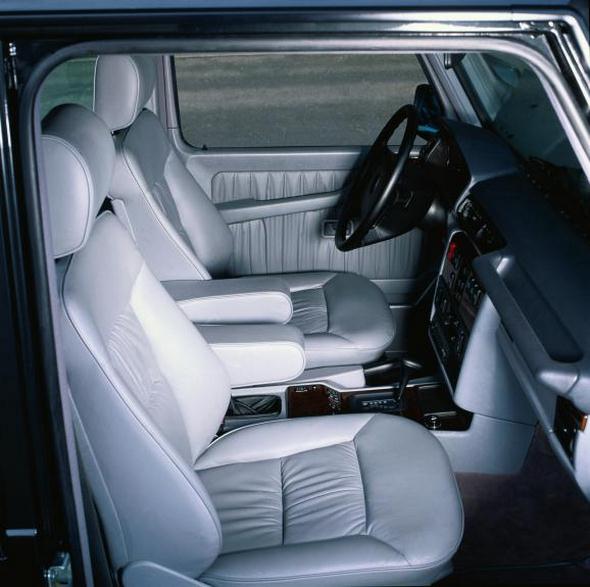
At the same time the design remains true to its down-to-earth, unmistakable style.”
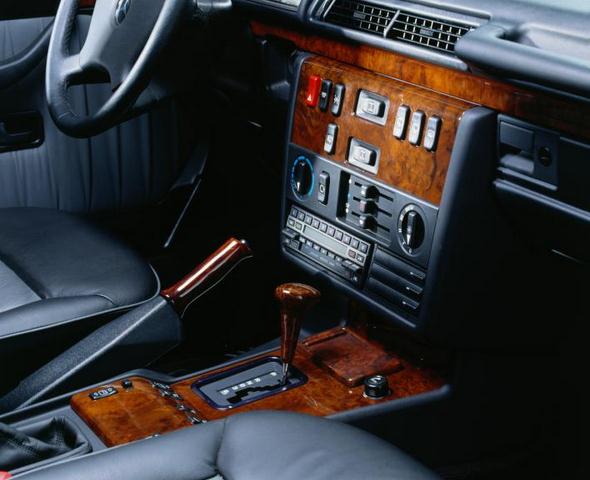
Even safer and more luxurious – the G-Class is largely hand-built in Graz, Austria.
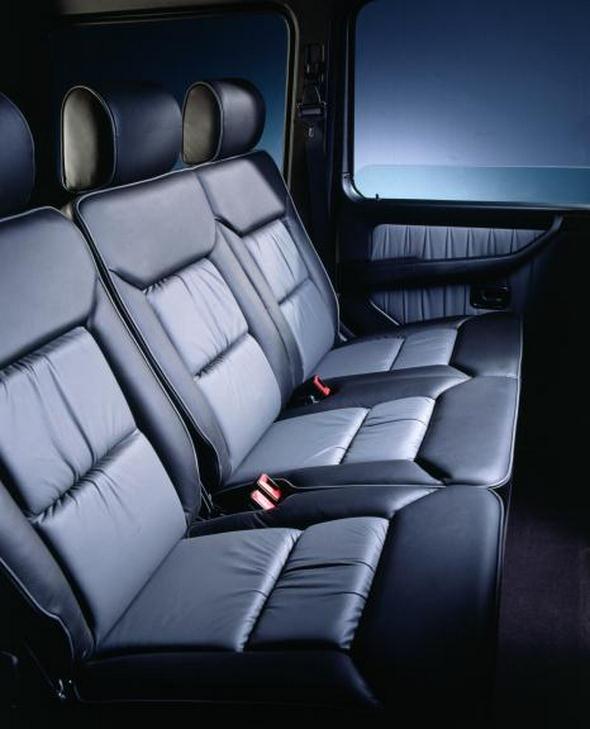
The most important new interior features of the 2012 facelift include:
- a completely re-designed, high-quality dashboard with central, free-standing 17.8 cm colour display unit,
- a completely re-designed centre console with centre dome and generously-sized trim elements,
- a new instrument cluster with round-dial instruments and TFT colour display, as well as new multifunction steering wheel with shift paddles,
- COMAND Online with internet access, operated through the COMAND Controller,
- re-designed, extremely functional and ergonomic controls,
- and a new air conditioning control unit.
In order to ensure that the G-Class loses none of its character, certain very typical features of the interior have been retained:
- grab handle on the dashboard for the front passenger,
- switches for the differential locks highlighted in chrome,
- shift lever on the centre console rather than on the steering wheel.
A few cautious modifications have been made to the exterior:
- new exterior mirrors,
- new LED daytime running lamps
- and, for the AMG models, a new radiator grille with twin slats, new bumpers with large air intakes as well as red brake callipers and, for the first time, 20-inch rims.

The outstanding functionality, reliability, quality and high-class style remain unchanged.

Five engine variants
The “G” family currently comprises two body variants – the four-door long-wheelbase Station Wagon and the G 500 as a Cabriolet with short wheelbase.
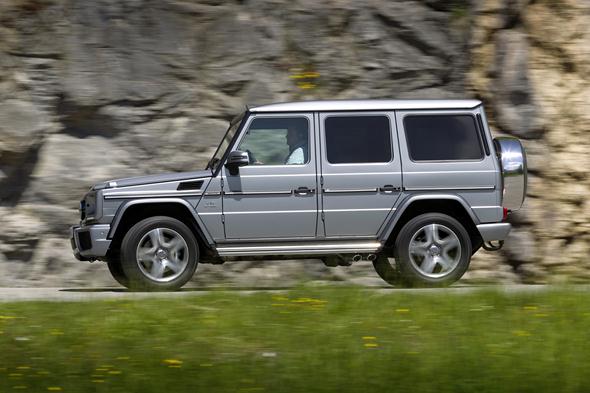
The entry-level model for the long-wheelbase Station Wagon is the G 350 BlueTEC with 6-cylinder diesel engine and a displacement of 2987 cc.
This four-cylinder unit has an output of 155 kW (211 hp) at 3400 rpm and produces torque of 540 Newton metres over a speed range of 1600 to 2400 rpm.

The BlueTEC technology developed by Mercedes-Benz is used to minimise the engine’s emissions, particularly of nitrogen oxide (NOx). The G 350 BlueTEC uses AdBlue®, an aqueous urea solution, which is injected into the exhaust-gas stream.
This process releases ammonia, which converts up to 80 percent of the nitrogen oxides into harmless nitrogen and water by a process of reduction in the downstream SCR catalytic converter.

Since the G-Class is often used in remote areas of the world, as indeed it was designed to do, the engineers have made things even simpler by integrating the AdBlue® filler cap into the vehicle’s filler neck compartment, accessible from the outside. One full tank of AdBlue® is good for around 12,000 kilometres.

The alternative to the diesel engine is the G 500, with its powerful 5.5-litre V8 petrol engine. This has an output of 285 kW (387 hp) and offers excellent torque of 530 Newton metres.
The same engine also ensures that the G 500 Cabriolet has generous reserves of power to deal with any situation.

New to the range are the G 63 AMG and G 65 AMG models, with which the performance brand of Mercedes-Benz meets the desire for yet more power.
To this end, AMG has fitted the four-door long-wheelbase Station Wagon of the G 63 AMG with a biturbo V8 engine, with an output of 400 kW (544 hp) and impressive maximum torque of 760 Newton metres.

This powerful AMG V8 engine is fitted as standard with the ECO start/stop function, which is an extremely effective way of helping the driver to reduce fuel consumption.

The new top-of-the-range model from now on is the G 65 AMG, meeting the requirement for a 12-cylinder engine in the G-Class.
Its performance figures are correspondingly impressive: 450 kW (612 hp) and 1000 Newton metres are there for the taking. The G 65 AMG is thus the most powerful series-production off-roader in the world.
The G-Class engines at a glance
| Model | Engine | Displacement cc | kW/hp at rpm | Nm at rpm | l/100 km | CO2 g/km |
| G 350 BlueTEC | V6 diesel | 2987 | 155/211 at 3400 | 540 at 1600-2400 | 11.2 | 295 |
| G 500 | V8 | 5461 | 285/387 at 6000 | 530 at 2800-4800 | 14.9 | 348 |
| G 500 Cabriolet | V8 | 5461 | 285/387 at 6000 | 530 at 2800-4800 | 14.9 | 348 |
| G 63 AMG | V8Biturbo | 5461 | 400/544 at 5500 | 760 at 2000-5000 | 13.8 | 322 |
| G 65 AMG | V12 biturbo | 5980 | 450/612 at 4300-5600 | 1000 at 2300-4300 | 17.0 | 397 |
Automatic transmission for lower consumption and more fun at the wheel
The G 350 and G 500 come with the 7G-TRONIC PLUS automatic transmission as standard. Now in its sixth generation, the multi-ratio automatic transmission was developed by Mercedes-Benz and has been produced since 1960.
The new version has been thoroughly revised to optimise consumption and comfort compared with its predecessor.

The new generation of the torque converter provides an improved dynamic response and reduced noise and vibration levels thanks to a new hydraulic circuit, as well as enhanced dampers and an optimised torque converter housing.
The extreme wheel-slip reduction of the torque converter housing, combined with

- larger mechanical damper de-coupling, helps to reduce consumption significantly;
- in addition, the gearshift program in ECO mode has been changed in favour of lower engine rpm at cruising speeds;
- friction-optimised bearings and seals plus a new automatic transmission oil (FE-ATF) with reduced viscosity in conjunction with an optimised additive package.

Compared with the previous transmission, this enhances the ease of shifting and reduces fuel consumption, quite apart from adding driving enjoyment.
The improved longevity of the new oil also means that oil change intervals have extended from 50,000 (old) to 125,000 kilometres (new).

The AMG SPEEDSHIFT PLUS seven-speed automatic used in the AMG models provides more than adequate power transmission.
Its most important characteristics: three transmission modes, an automatic double-declutching function and defined ignition and injection retardations to ensure shorter shift times when changing up at full load.

Technical superiority off-road
The technical qualities of the G-Class are highly prized. The tremendous torque of its engines makes the luxury off-roader an excellent vehicle for towing, while three electrically controlled 100-percent differential locks that can be activated while the vehicle is moving in low gear mode, a reduction gear and rigid axle are characteristics that make it an unrivalled proposition in rough, off-road terrain.

Fundamental to the vehicle’s capability in even the toughest terrain is its dip-primed and power-coated ladder frame, made out of sheet steel up to four millimetres thick, with solid longitudinal sections and cross-members.
This design is considerably more robust and thus better suited for off-road use than an integral body construction.
The strong ladder frame not only has the stability to deal with torsional forces but also forms the lowest point of the structure, so protecting the major assembly, fuel tank and exhaust system from surface contact, for example when the vehicle is negotiating obstacles.
Suspension ensures maximum off-road capability
The suspension of the G-Class is also specially designed for driving in challenging terrain. The key factors here are its high ground clearance and long shock course for the springs.
Together they provide the basis for the excellent off-road capability of the G-Class. The figures:
- slope climbing ability of up to 80% depending on the surface,
- 21 cm ground clearance,
- maximum fording depth of 60 cm through water and mud,
- tilt angle up to 54%,
- angle of approach/departure up to 36° at the front and 27° at the rear (differs with AMG).
Mechanical and electronic systems work hand in hand
The G-Class is the only off-road vehicle to combine the electronic traction system 4ETS with a transfer case and three 100% differential locks, so allowing the following systems to move the vehicle forward safely and reliably:
- the permanent all-wheel drive is designed for maximum traction and distributes the power to the front and rear axles in the ratio 50:50
- the electronic traction system 4ETS guides the driving power to the wheels with the best traction, so making it much easier to negotiate snow and ice-covered roads as well as demanding off-road routes
- the three 100% differential locks apply the driving power precisely where the best traction is available. They can be switched on individually while the vehicle is moving. Only one wheel needs
to find grip in order to move the vehicle forward - the low-range ratio helps to ensure maximum traction on difficult surfaces, for example in mud or on sand. It can be engaged at speeds of up to 40 km/h in transmission mode N, using the Low Range switch.
The latest safety features

The new generation of the G-Class also offers a range of exemplary safety features. For example, the luxury off-roader features a completely reconfigured ESP® with an automatic control system that includes start-off assist and a HOLD function, both for easier hill starts.

And in an emergency braking situation, when the driver suddenly releases the accelerator and hits the brake pedal, the brake system increases the pressure in the brake lines, so applying the brake pads to the disks.
This ensures maximum effect as soon as the brake is applied. This “pre-filling” function supports the Brake Assist system that is already fitted as standard.
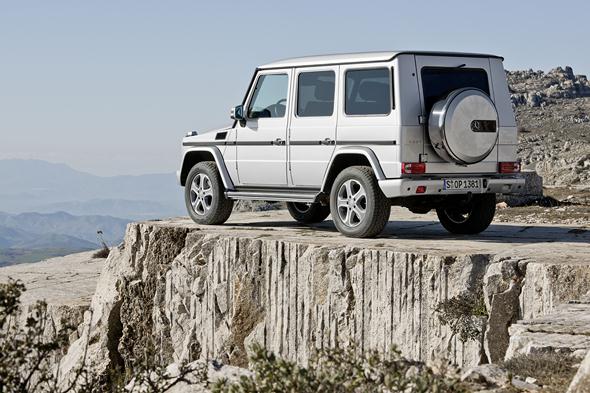
Also new in the G-Class are two radar-based systems: Blind Spot Assist and the adaptive cruise control system DISTRONIC PLUS.
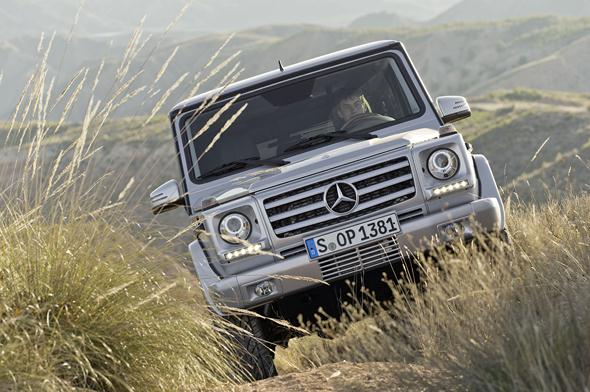
DISTRONIC PLUS adjusts the distance to the vehicle in front automatically. If necessary, it can apply the brakes to bring the off-roader to a stop, and then accelerate again.
This takes some of the strain off the driver, particularly in bumper-to-bumper driving conditions.

If the distance starts to narrow too quickly, the system gives visual and acoustic warnings, thereby prompting the driver to take action, at which point Brake Assist (BAS) also intervenes to help.
Blind Spot Assist issues a warning if it identifies the presence of a vehicle where it can only be seen with difficulty, in other words in the driver’s “blind spot”.
The warning takes the form of an acoustic alert and of a signal in the relevant exterior mirror.

For customers ordering the optional trailer coupling, the ESP® system includes a trailer stabilisation feature that acts to nip any threat of sinusoidal oscillation, or ‘fishtailing’, on the part of the trailer in the bud, so making driving with a trailer far safer.
This additional ESP® function detects the trailer as soon as the electric connector plug is inserted in the socket on the towing vehicle.

The ESP® trailer stabilisation system makes use of the ESP® sensors to enable it to counteract any fishtailing of the trailer at speeds higher than 65 km/h by alternating brake application to the left and right front wheels.
This is generally sufficient to eliminate the problem and prevent any further risk.

In very severe cases of fishtailing oscillation, the engine torque is also reduced and the towing vehicle is braked on all four wheels, in order to bring the vehicle back to within a safe speed range as quickly as possible.
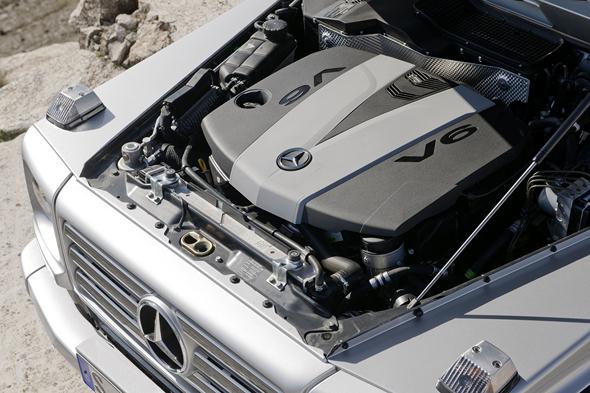
A useful aid to parking is provided by the PARKTRONIC system, which now monitors the area both to the front and to the rear of the vehicle.
In the G-Class, this can be combined with a reversing camera, so improving both visibility and safety when reversing.

The G-Class for professionals
In addition to the luxury versions of its G-Class off-roader, Mercedes-Benz also offers the G-Class Professional model. This somewhat stripped-out, more practically-oriented version focuses on the robustness and reliability of the G-Class.
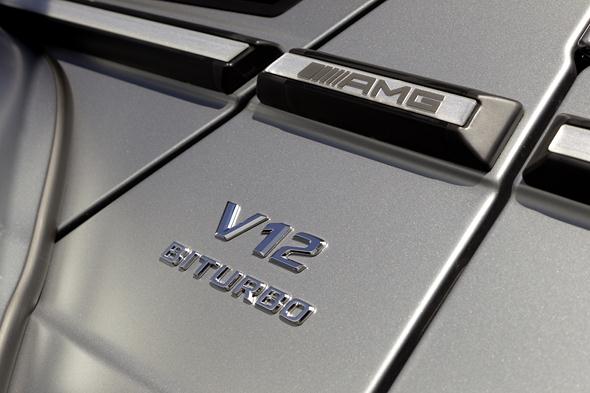
It has been specifically created for extreme operations in rugged terrain and, as such, is eminently suitable for use by rescue services, for example.
There are of course also private individuals who opt for the classic model for extreme off-road and expedition use.
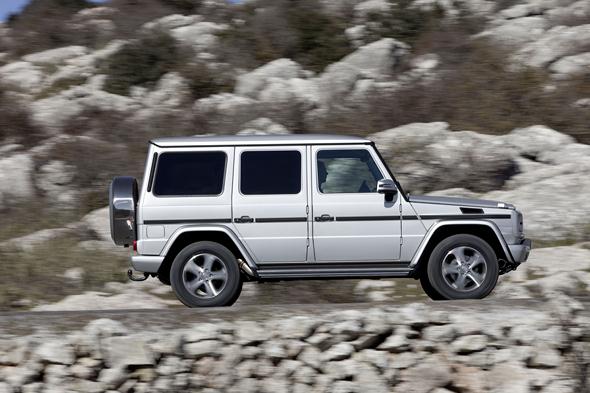
Design
New interior for this true character
- LED daytime driving lamps and new exterior mirrors
- Completely redesigned dashboard and centre console
- High-quality trim
- COMAND Online with internet access
The exterior of the G-Class has changed little since 1979. It retains the timeless design that has made it a trendsetter in the off-road vehicle segment.
This luxury off-roader from Mercedes-Benz has long been considered a design icon. So, even with this latest facelift, there seemed little need to make major changes.

Instead, a little subtle upgrading of the exterior design has brought the G-Class into line with the current state of the art. The upgrading includes new exterior mirrors with integrated directional indicators and front area lighting, painted in the vehicle colour.
The warning signal for the optionally available new Blind Spot Assist system is also integrated here. A memory function allows up to three drivers to store their personal settings for the electrically folding mirrors.

Also new are the LED daytime running lamps located underneath the round headlamps in the headlamp unit and the optional 18-inch bi-colour light-alloy wheels.
Generally speaking, the exterior design of the G-Class serves to underline its robustness, sense of purpose and outstanding off-road capability.
The side view is characterised by its clear lines and broad, flat surfaces. The side skirts, beltline and roof edge are aligned in parallel.
Similarly severe and functional in its horizontal alignment is the rub strip at door-handle height. Two large windows in the rear are a further characteristic of the long-wheelbase Station Wagon.

Characteristic features of the front of the vehicle are, above all, its distinctive three-louvre radiator grille featuring a central three-pointed star, the steeply raked A-pillars and the upright windscreen.
The round headlamps feature state-of-the-art bi-xenon technology, while the oval fog lamps integrated into the front bumper incorporate the cornering light function.
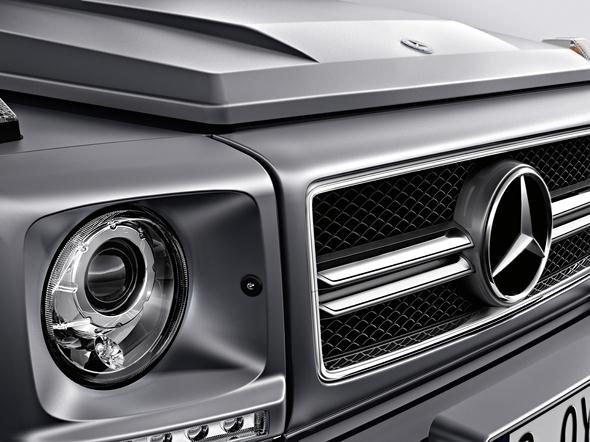
With its broad track and distinctive wheel arch lining, the G-Class displays a very solid stance when seen from the rear. The rear fog lamp and reversing lamp are integrated into the rear bumper.
Access to the load compartment is via a large rear door, hinged on the left, which carries a spare wheel prominently mounted on the outside.

The G 500 runs as standard on 18-inch 5-spoke light-alloy wheels (265/60 R18 on 7.5 J x 18 ET63). The standard specification of the G 350 BlueTEC includes 16-inch 5-spoke light-alloy wheels (265/70 R16 on 7.5 J x 16 ET63).

New options for the exterior of the G-Class include the colours magnetite black, tenorite grey and indium grey. All in all, the paint range comprises 21 colours, of which 18 metallic and eight designo shades.

Interior – with added luxury and comfort
A low window line and the raised seat position have always ensured exceptional all-round visibility in the G-Class – an advantage not only in awkward terrain.
The fundamental off-road character of the vehicle forms a successful symbiosis with the high-grade luxury appointments.
Just a glance – and a touch – are enough to recognise that only the finest materials have been used here. Every single detail is a fine example of meticulous handcraftsmanship.

Mercedes-Benz has now enhanced this high aesthetic standard still further with the introduction of a redesigned dashboard with a new instrument cluster and a completely new centre console with centre dome.
Many of the characteristic elements in the interior have, however, been retained.
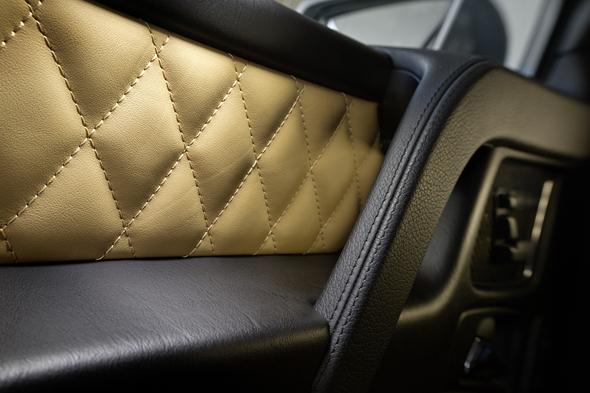
These include the grab handle for the front passenger, the switches for the three differential locks, which are clearly positioned in the driver’s field of view and highlighted in chrome trim, and a redesigned selector lever in the centre console.
When it’s dark, ambient lighting helps to create a stylish atmosphere.

The cockpit is well laid out and functional in structure. The dashboard incorporates an instrument cluster with two sporty round dials plus, in the middle, a multifunction TFT display with a screen diagonal of 11.4 cm, which shows information from the on-board computer relating to the assistance systems.

The driver sits behind a new, electrically adjustable 4-spoke multifunction steering wheel with a rim trimmed in nappa leather and twelve function buttons.
The steering wheel can be adjusted electrically and pivots automatically upwards in order to make getting in and out of the vehicle easier.
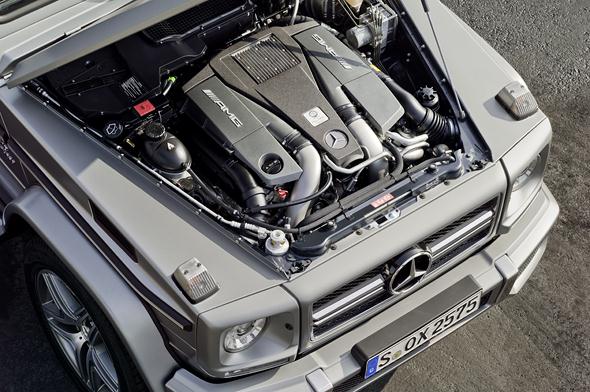
The centre dome, with vent openings in the middle and a free-standing central display, is slightly convex in shape and tapers away towards the base.
Thematically grouped clusters of controls, with flawlessly designed and yet extremely functional switches, are intuitive to use. The COMAND Online system is controlled via the COMAND Controller on the front of the armrest.
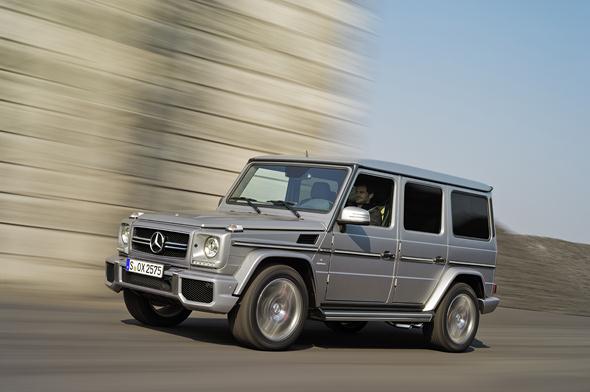
The switches for the three differential locks have a high-quality chrome finish. The various controls are similarly new and high-quality in design.

The stylish detailing of the vehicle includes the generous use of high-quality trim. The G 350 BlueTEC is fitted as standard with anthracite poplar wood trim, while the G 350 features burr walnut wood trim (also available as an option for the G 350 BlueTEC).
Optional alternatives include designo black piano lacquer, champagne white and light brown poplar silk matte trim (standard on the G 63 AMG and G 65 AMG), as well as AMG carbon-fibre trim including a designo wood/leather steering wheel with a designo black piano lacquer finish.
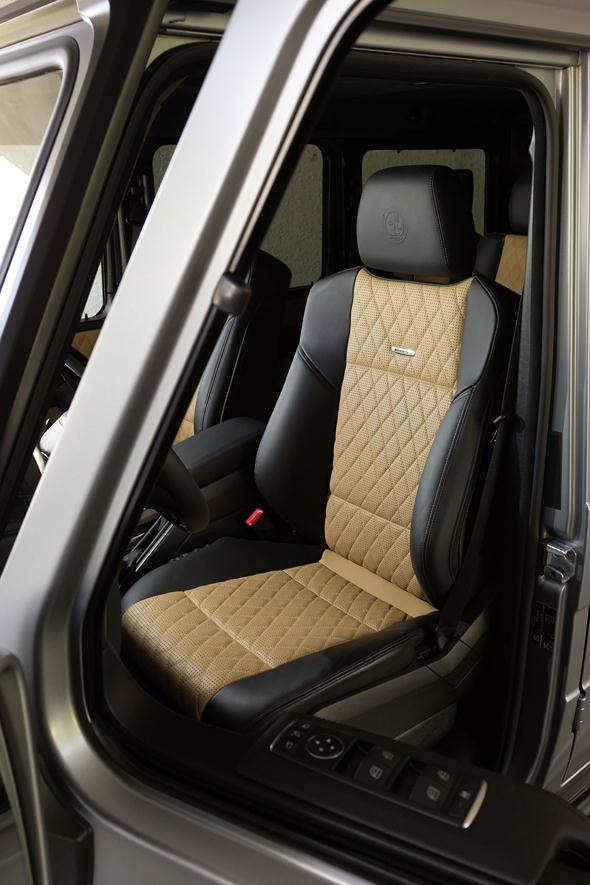
Seats with long-distance comfort
The seats in the G-Class are equipped, even in the standard specification, with numerous convenience functions.
These include, for example, a memory function for the driver’s seat, seat heating front and rear, and NECK-PRO high-comfort head restraints on the front seats.
The seats also include electric lumbar support for both driver and front passenger, making them particularly comfortable on long journeys.
Such ride comfort may be further enhanced with the addition of the optional Seat Comfort package, comprising multicontour and climatised seats.

In the standard-spec G 350 BlueTEC model, passengers take their places on high-quality, black, cloth-upholstered seats. Leather seats in grey, black and chestnut are available for the G 500 (also available as an option for the G 350 BlueTEC).
The G 63 AMG in the standard version offers a choice of eight colours of designo leather, including for the ruffled leather door centre panels (also as an option for the G 500 and the G 350 BlueTEC).
The G 65 AMG comes as standard with a designo Exclusive package that includes sports seats in two-tone design leather (choice of six colours) with diamond-patterned quilting for the seats and door panelling – this package is also available as an optional extra for the G 63 AMG.
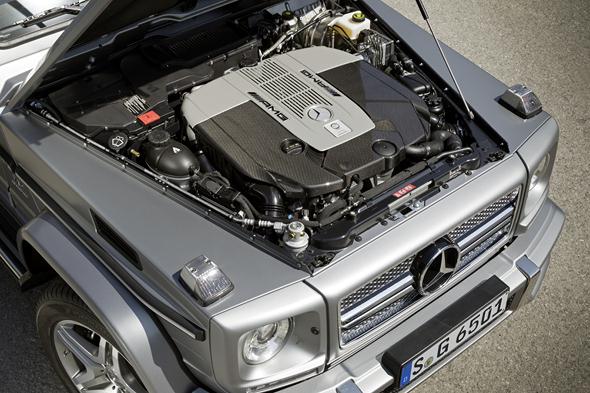
State-of-the-art infotainment with internet access
A visual as well as functional highlight that is fitted as standard in all versions of the G-Class is the new COMAND Online “Cockpit Management and Data System” with internet access and 6-disc DVD changer.
This is a car radio and a CD/DVD player in one. Bluetooth telephony and simplified car telephone operation are included in the scope of this system.
The free-standing, high‑resolution TFT colour display with a screen diagonal of 17.8 cm (800 x 480 pixels) is positioned above the centre dome. Positioning the monitor here minimises the extent to which the driver is distracted.
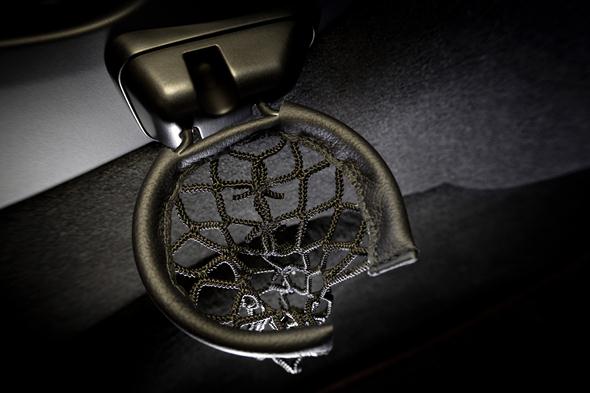
COMAND Online is operated via what is known as a “Controller”, located just in front of the armrest on the centre console.
This is the optimum ergonomic position for it, allowing easy and safe operation. The Controller is a very high-quality rotary pushbutton with a galvanised finish, and can be moved intuitively in eight directions.
Functions can also be activated or confirmed by turning and pressing it. A user-friendly new control logic for the main menus as well as for the sub-menus, which open up step by step, enables drivers to leaf through the menus safely and in a targeted manner.
COMAND Online encompasses the following features:
- FM radio twin tuner with phase diversity and an additional RDS/TMC tuner for traffic information,
- entry-level 4 x 25 W audio signal amplifier,
- six-disc DVD changer,
- internet access
- integrated navigation system with map display including bird’s eye view and 3D map,
- integrated hard disc for navigation data and additional functions (e.g. music server),
- LINGUATRONIC voice-operated control system,
- off-road functions such as route recording or a compass function are also built in, so enabling the driver to find his/her way in rough terrain. In this case the compass direction is shown both on the display of the new instrument cluster and on the COMAND screen.
COMAND Online also supports the following components:
- Harman Kardon Logic7® surround sound system,
- Media Interface,
- DAB receiver (Digital Audio Broadcast),
- TV receiver.
COMAND Online provides internet access, making it possible to browse freely on the internet and gain quick access to the Mercedes-Benz Online service whenever the car is stationary. These integral services include weather information and a POI search via Google. A route that has been previously configured on a PC using Google Maps can also be sent to the car in this way.
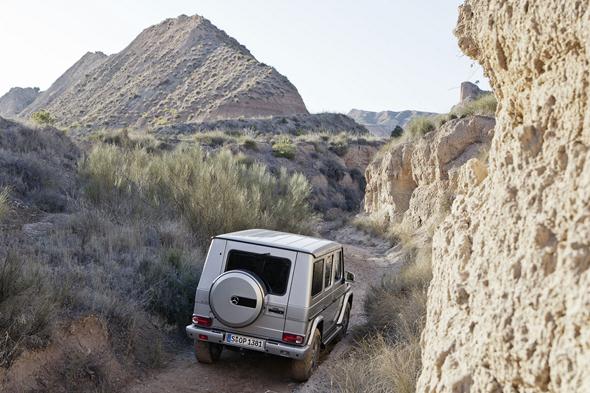
The navigation function in COMAND Online also has new functions to offer, such as a 3D display with three-dimensional city views.
Also new: routes covered can be recorded and repeated later, specific personal destinations can be stored or imported via an SD card, plus four alternative routes can be displayed on the navigation map, including a particularly economical variant.

COMAND Online also incorporates digital operating instructions for the G-Class. Owners can thus browse at their convenience through this reference work, enhanced here with special graphics, on the COMAND display unit.

New online services for COMAND Online
Three Mercedes-Benz apps are available to customers for use with COMAND Online:
- for calling up weather forecasts and maps,
- for a Local Search from Google, displaying Google Street View images,
- plus Google Panoramio photos, with the option of searching for destinations in the extensive Google archives.
All COMAND Online users also have access to a Facebook app.
Further apps are also available: a free news app, a Yelp app (in the US version only), and apps for share prices and a car park finder:
- With the news app, the user is always up-to-date with what’s happening in the world. Sorted according to categories such as financial or sports news, it always finds the latest news bulletins.
- The Yelp app (in the US version only) enables users to search for restaurants from their vehicle, using the social database filled by the Yelp Community. The Yelp app offers a choice according to various restaurant categories, within which it is possible to search for recommendations close to the current position, at the destination point programmed into the navigation system, or at any other specific location.
- The app which searches for car parks calls up the current occupancy of multi-storey car parks in real time, as well as other information such as opening times and charges. The app supplies data in Germany, Austria and Switzerland. Once a suitable parking opportunity has been found, the driver can start the navigation to that destination or call the telephone number provided.
Individualisation
Something to suit every taste
- Specially developed appointments packages
- designo range for hand-finished options
The G-Class has a high level of specification even to begin with, while an extensive range of optional extras covers many additional requests for individualisation.
On top of all this comes the comprehensive designo range, designed to help fulfil even the most esoteric of requirements. Some suggestions from the designo ‘Manufaktur’, or hand-finishing section, are even included in the catalogue.
For those wishing to upgrade their G-Class further, a range of five high-end equipment packages have been put together specifically for the G-Class.
The Chrome package includes stylish design elements in the form of additional chrome trim for both the interior and exterior (standard for the G 63 AMG and G 65 AMG models). The package includes:
- radiator grille with chrome inserts,
- chrome trim around the wood panel for the seat adjustment switches,
- chrome surrounds around the loudspeakers in the front doors,
- protective sill for load compartment with “Mercedes-Benz” or “AMG” lettering
The Exclusive package enhances the high-class appeal of the G-Class even further. The package includes:
- dashboard in leather,
- illuminated door sill panels,
- roof lining in alcantara anthracite,
- Seat Comfort package.
The Exterior Stainless Steel package makes for a glittering appearance.
The package includes (standard for the G 63 AMG and G 65 AMG models):
- running boards on both the left and right-hand sides,
- stainless steel spare wheel cover with 3D Mercedes-Benz star
The Sports package highlights the dynamic qualities of the G-Class.
The package includes:
- Exterior Stainless Steel package,
- AMG flared wheel arches in the vehicle colour,
- 18-inch 5-twin-spoke light-alloy wheels, painted in titanium grey (with 265/60 R 18 on 7.5 J x 18 ET43),
- inserts in a striped anthracite finish,
- designo velour floor mats,
- sports exhaust system (only available for the G 500),
The designo Exclusive package (standard for the G 65 AMG, optional for the G 63 AMG) enhances exclusivity to the highest level. The package includes:
- front AMG sports seats
- seat and door centre panels and rear door insert in designo leather with diamond-pattern quilting effect,
- upper and lower parts of dashboard finished in black designo nappa leather,
- AMG badges on the front-seat head restraints (V12 only), two-tone designo leather with diamond-pattern quilting effect, in conjunction with six leather colours and Seat Comfort package.
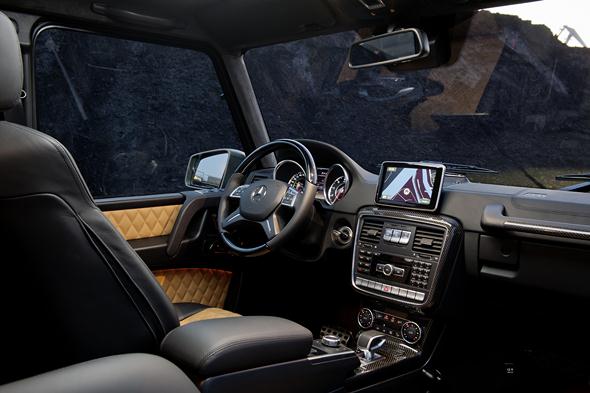
Always at the cutting edge
The evolution of the G-Class
1979
The G-Class is presented to the press for the first time in the south of France. Production gets underway with the 230 G, 240 GD, 280 GE and 300 GD models.
1980
An enclosed van-type model with short or long wheelbase is added to the model range.
1981
The first facelift. Automatic transmission, air conditioning, longitudinal bench seats for the load area, additional fuel tanks, a “tropical roof”, protective headlamp grilles, a cable winch, a hardtop for the Cabriolet and a mechanical power take-off are all available as options for the 280 GE and 300 GD. A choice of five different paint colours has risen to 22.
1982
The 230 G is fitted with a fuel injection system and becomes the 230 GE.
Recaro seats, auxiliary heating, wide-base tyres on light-alloy wheels and wheel-arch flaring can be ordered as options.
1983
The 230 GE is optionally available with a four-speed automatic transmission.
The second facelift sees four new metallic colour shades and a five-speed transmission added to the list of equipment – as well as eight-inch tandem brake boosters and a new folding soft top for the Cabriolet.
1985
A facelift adds differential locks, central locking, a rev counter and split rear bumper to the list of standard equipment.
1986
A closed-loop catalytic converter becomes available for the 230 GE.
1987
The fourth facelift brings power windows, an automatic aerial, a combined luggage cover and retaining net for the load area, and a larger fuel tank.
Unveiling of the 250 GD with 62 kW/84 hp.
1988
New six-cylinder diesel engine for the 300 GD.
The driver’s and front passenger’s seats are fitted with armrests.
1989
Launch of the new 463 model series with permanent four-wheel drive, and manually selectable ABS at the International Motor Show (IAA) in Frankfurt.
1990
The 463 model series is launched with the 230 GE, 300 GE, 250 GD and 300 GD. Customers can choose from three body variants.
1992
The new 350 GD TURBODIESEL is unveiled.
Cruise control, a stainless-steel spare wheel cover, side-mounted running boards, a luggage compartment cover and burr walnut trim are available as options.
1993
Unveiling of the special model 500 GE. This offers a range of luxury appointments and is built in a limited edition of 500 units.
1994
A second facelift for the 463 model series brings internally ventilated front disc brakes and a driver airbag.
1995
All G-Class models are fitted with remote-controlled central locking and an immobiliser.
1996
The G-Class Cabriolet with electrohydraulic soft top is presented, along with the G 300 TURBODIESEL.
Facelift and upgrade of standard equipment with a headlamp cleaning system, cruise control and a front passenger airbag.
1997
The electronically controlled five-speed automatic transmission becomes available for the G 300 TURBODIESEL and the G 320.
The 290 GD TURBODIESEL with 88 kW/120 hp replaces the 290 GD with naturally aspirated diesel engine.
1998
Mercedes-Benz launches the new G 500 with V8 engine (218 kW/296 hp).
1999
The multifunction steering wheel is added to the list of standard equipment for the G-Class.
Launch of the G 55 AMG. Its V8 engine delivers 260 kW/354 hp.
The Mercedes-Benz G 500 Guard appears in three different special-protection versions.
2000
The new 2001 models are unveiled at the Paris Motor Show – with a new interior offering enhanced levels of comfort.
A new V8 diesel engine (184 kW/250 hp) for the G 400 CDI.
The V8 models are fitted with new light-alloy wheels, a chrome-plated radiator grille and bumpers in the vehicle colour.
2001
The IAA in Frankfurt sees the unveiling of the G-Class with new dynamic
control systems. These include the ESP® Stability Program, BAS Brake Assist and the new ETS Electronic Traction System.
2002
The new G 270 CDI makes its debut powered by a 115-kW/156-hp five-cylinder diesel engine.
2003
Indicator repeaters are integrated into the exterior mirrors of the G-Class.
2004
World premiere of the new G 55 AMG with a supercharged V8 engine developing 350 kW/476 hp.
2006
Introduction of the new G 320 CDI with diesel engine (165 kW/224 hp), fitted as standard with a diesel particulate filter.
2007
Another facelift. LED-look tail lights. New instrument cluster with four analogue instruments mounted in chrome rings. New four-spoke multifunction steering wheel, modified centre console. COMAND APS as standard for the models G 500 and G 55 AMG.
2008
Revised radiator grille with three slats. New V8 engine with displacement and 5.5 litres and output of 388 hp (285 kW). Bluetooth hands-free system for mobile telephone.
2009
New seats plus interior design modifications
2011
V6 diesel engine in the G 350 BlueTEC with state-of-the-art BlueTEC technology and AdBlue® injection, delivering impressively low emissions and output of 155 kW (211 hp).
2012
G63AMG and G65AMG

While competitors change – the “G” remains
Stuttgart – For the third time the legendary G-Class has been successful in the “Off-Road Vehicle of the Year 2006” vote by readers of the well-known motoring magazine OFF ROAD.
The old-stager in the four-wheel drive market was able to triumph over its rivals in the “Classic” category.
This latest victory reaffirms the model strategy of Mercedes-Benz, which is just as unique as the classic off-roader itself: the G-Class has retained its striking body shape and stable foundations in unchanged form since 1979.
At the same time constant evolution has kept the “G” at the technical forefront.
Neither is there an end to this success story in sight, as the new special model Grand Edition demonstrates.
Alongside the M-Class and the new GL‑Class, the G-Class will continue to take its place in the Mercedes-Benz range of highly capable off-roaders.
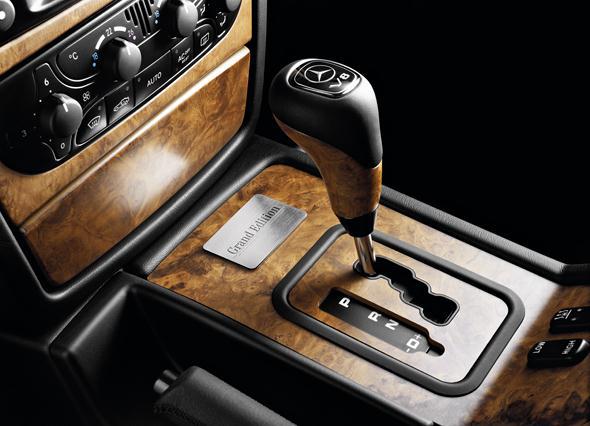
The readers of the magazine OFF ROAD have voted the legendary progenitor of all Mercedes-Benz off-roaders, which is now entering its 27th year in production, “Off-Road Vehicle of the Year 2006” in the “Classic” category.
This latest public accolade makes the G-Class one of the most highly decorated models in the off-road sector, as a glance at the most important worldwide awards will confirm.
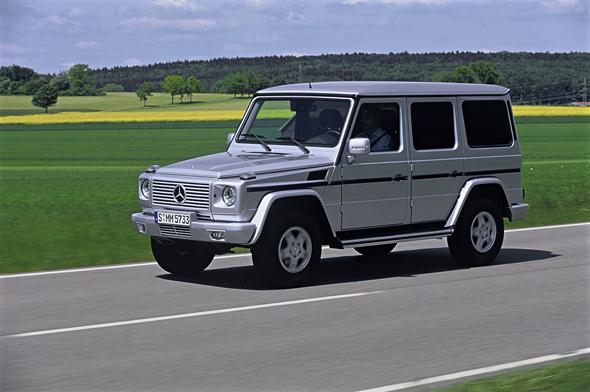
No less than 13 times, the readers of the motoring magazine “auto, motor und sport” have voted this four-wheel drive vehicle the world’s best off-roader.
Following its victory in the 1983 Paris-Dakar Rally, the Australian motoring magazine “bushdriver” proclaimed the G-Class as the best 4×4 off-roader of the year.
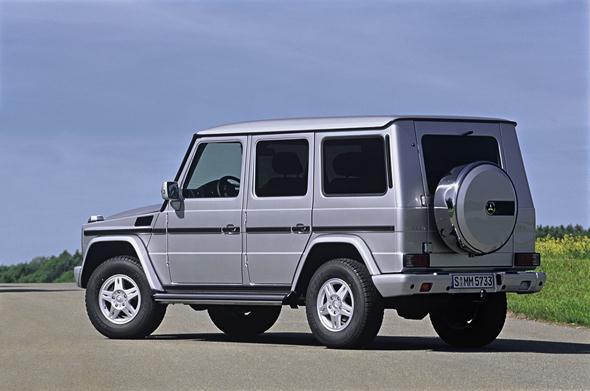
And in 1995 the readers of the boating magazine “Boote” voted the G-Class the best towing vehicle. In 2003 this successful model was nominated as the “Classic of the future” by the magazine “Motor Klassik”.
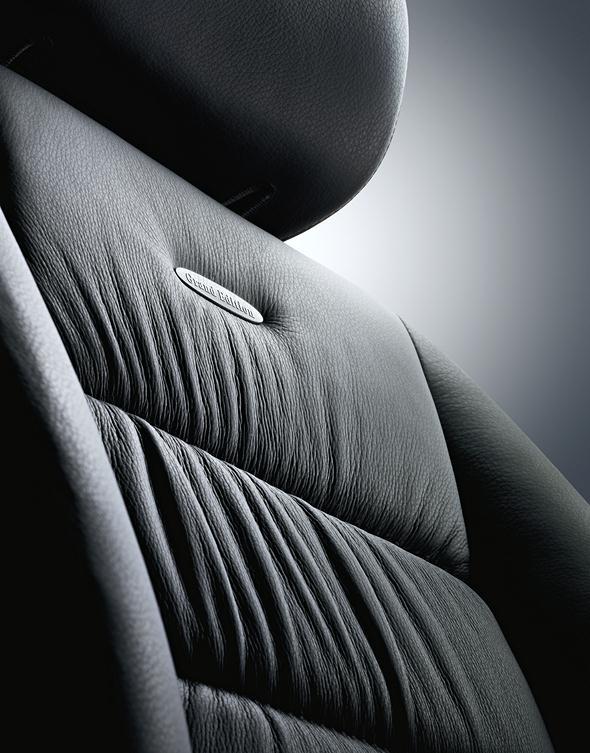
The classic amongst the Mercedes-Benz off-roaders offers a superior synthesis of highly efficient drive and dynamic handling systems: In addition to permanent four-wheel drive with a reduction gear, the standard features include the electronically controlled traction system 4ETS, the Electronic Stability Program ESP® and three differential locks which can be selected at the touch of a button.
Magna Steyr in Graz, Austria has been producing the G-Class on behalf of Mercedes-Benz since 1979; more than 185,000 examples have been produced to date.
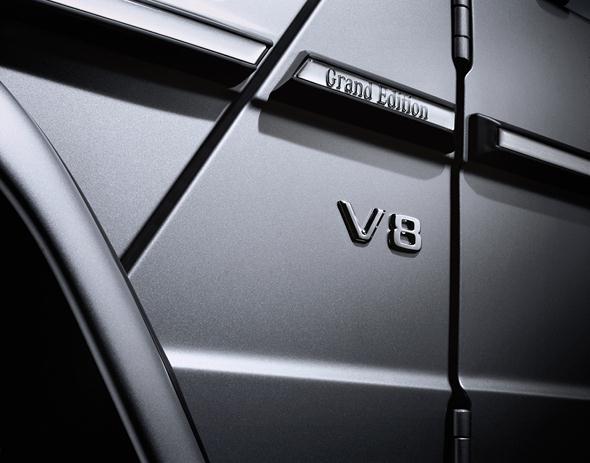
Exclusive paint finish for the special model “Grand Edition”
In line with the decision to continue production of this classic off-roader even after 26 years, Mercedes-Benz is introducing the exclusive special model “Grand Edition”. Dr. Klaus Maier, the Executive Board member responsible for sales and marketing at Mercedes Car Group: “Our G-Class impressively combines classic off-road vehicle values with the very latest automobile technology.
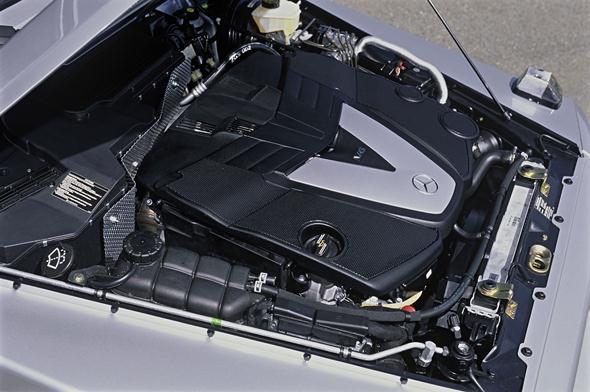
The new special model Grand Edition is an ambassador for the outstanding career of this modern-day classic.” Available only with a long wheelbase and V8-engines, the models in this special series are the G 500 with 218 kW (296 hp) and the G 400 CDI with 184 kW (250 hp).
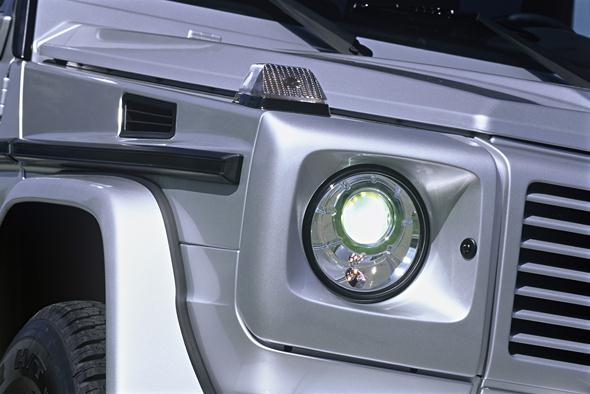
All versions are available with the optional special paint finish “allanite grey magno”. In contrast to conventional metallic paintwork, a clear topcoat protects the surface and lends an exclusive appearance to the “Grand Edition” models.
Additional features include brushed aluminium trim strips with integrated “Grand Edition” lettering.
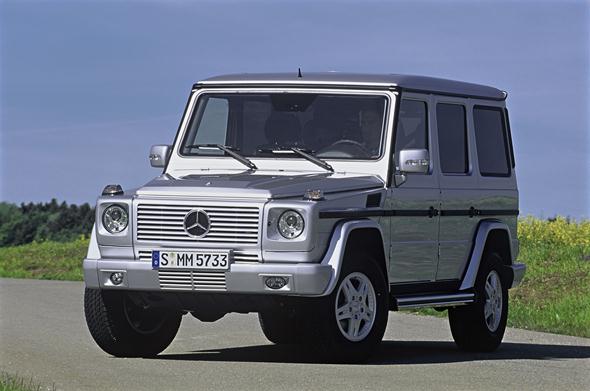
The interior atmosphere is no less exclusive. Specifically for this special series – and in line with the inherent charm of the G-Class – the upholstery is of open-pored, non-embossed natural leather.
Other interior features include matte-silk wood trim on the dashboard and centre console, as well as illuminated door sills with “Grand Edition” lettering.
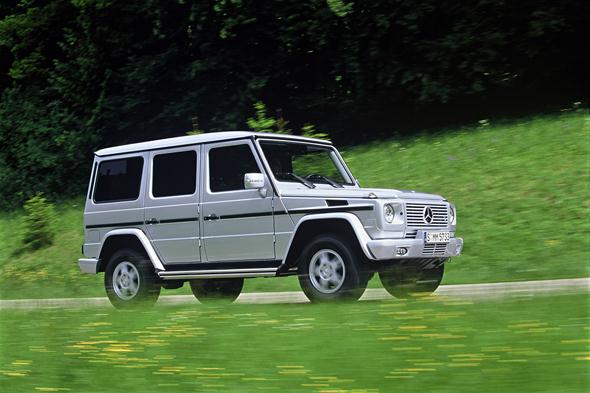
The special model is available from March and costs 74,600 Euro (plus 16% VAT).
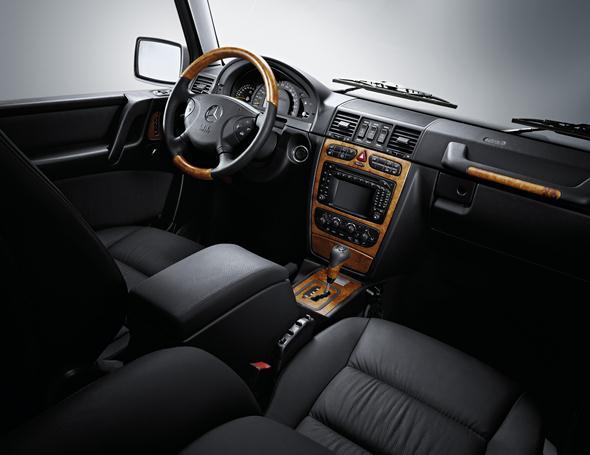
When in February 1979 the Mercedes-Benz G-Models were presented, a totally new terrain was entered. Already during the war Mercedes-Benz had made cross-country cars which were, however, primarily used by civil as well as non-civil state institutions.
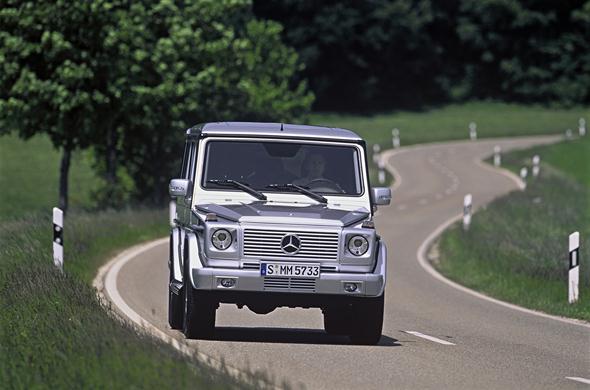
The new generation of off-road cars were, on the one hand, conceived as an exclusive vehicle for free time activities, on the other hand, for heavy use in industrial and community areas.
The development took place in co-operation with the Steyr-Daimler-Puch AG which extended the Puch plant in Graz-Thondorf for the series production of the G-Models.

First, on the basis of a co-operation contract, the “Gelände-Fahrzeug GmbH” (off-road vehicles ltd.), in which both partners participated with 50 %, signed responsible for the production.
In August 1981 the participation of Daimler-Benz in the GFG was given up.

Ever since, Mercedes-Benz off-road vehicles are produced by Steyr-Daimler-Puch as subcontractors. In Austria, Switzerland and the COMECON countries the otherwise totally identical vehicles are sold under the trademark “Puch”.
The G-Series model range originally comprised four engine- and five body-variants as well as chassis with two different frame lengths and wheelbases.
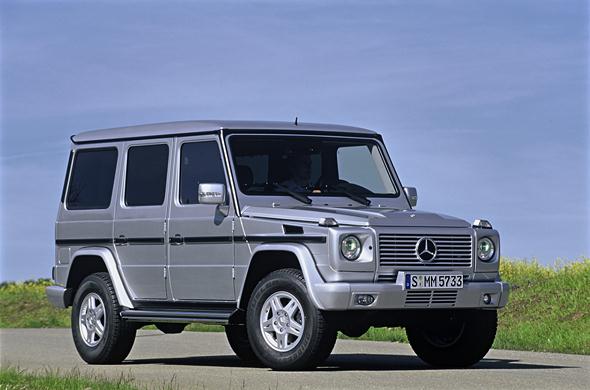
Besides an open car with short wheelbase one could also choose a station wagon, as well as a box-type truck on a short or long chassis.
As to aggregates and engines one had gone back to proven components – quite in line with the modular system long practised by Daimler-Benz.
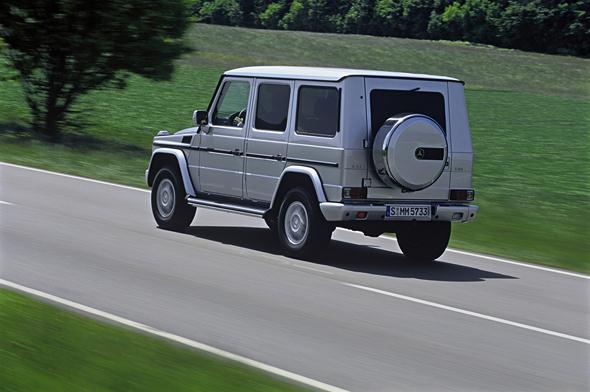
As engines the 2.4-liter and 3.0-liter Diesel aggregates, the 2.3-liter carburettor engine and the 2.8-liter injection engine, all of them known from series 123, were used. Internally all models and variants were assigned to series 460.

In the course of continuous model improvement and further development the interior equipment was refined several times and the range of special equipment constantly extended.
In addition, the range of engines was changed as well. In April 1982, 230 GE with the 2.3-liter injection engine M 102 was presented.
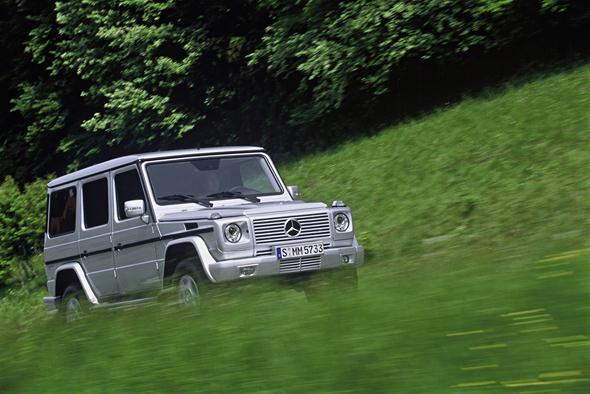
On the domestic market it functioned as the successor of the former 230 G. Since 1986 it was also available on demand with a three-way catalyst.
Since 1986 a variant with 2.0-liter injection engine was exclusively produced as an export model for Italy. In October 1987 the 250 GD with its 2.5-liter 5-cylinder Diesel engine OM 602 was introduced into the market and replaced the proven 240 GD.
G 55 AMG Kompressor now with 368 kW/500 hp
Power increase for the AMG classic
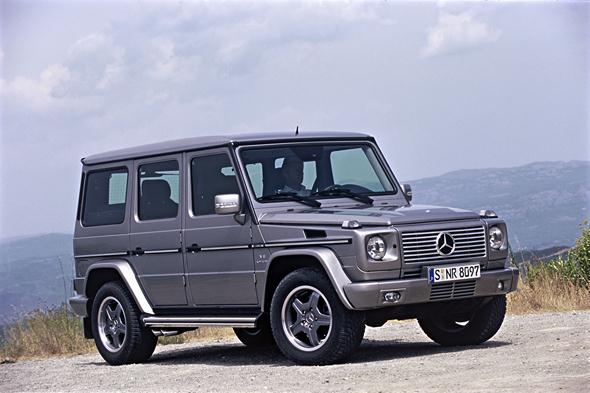
Affalterbach – What is perhaps the strongest character in the Mercedes-AMG model range has been given a shot in the arm. Increased to 368 kW/500 hp, the output of the G 55 AMG now exceeds that of the predecessor model by 18 kW/24 hp.
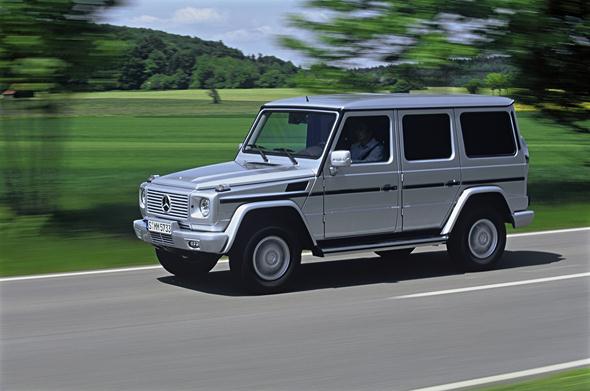
At the same time this classic cross-country vehicle has been treated to enhanced standard equipment which includes new AMG light-alloy wheels, bi-xenon headlamps, foglamps with a cornering light function and new paint finishes with greater scratch resistance, based on nano-technology.
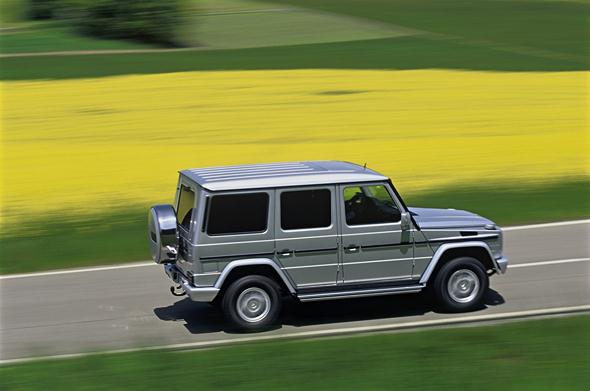
The increase in output from 350 kW/476 hp to 368 kW/500 hp is due to an enhanced and retuned engine control unit. The supercharged 5.5-litre AMG engine generates its maximum torque of 700 newton metres between 2750 and 4000 rpm.
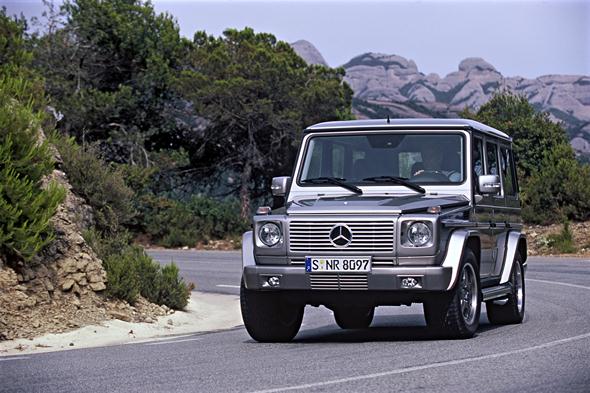
These exceptional figures are a guarantee of effortless performance: the G 55 AMG accelerates from zero to 100 km/h in just 5.5 seconds (preceding model: 5.6 s), the maximum speed remains 210 km/h (electronically limited).
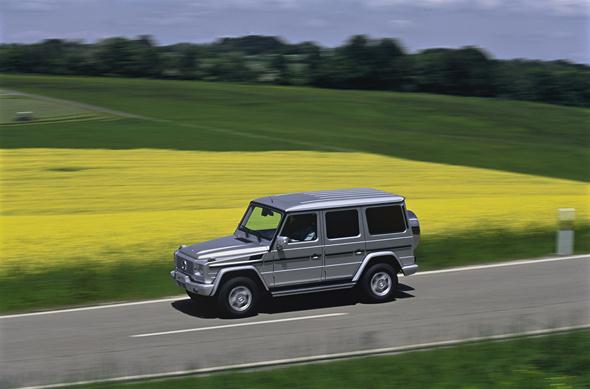
The AMG sports exhaust system with its two oval twin tailpipes emerging at an angle in front of the rear wheels, as well as the characteristic AMG V8 sound, provide an ample visual and acoustic indication of the engine power to be expected of the G 55 AMG Kompressor.
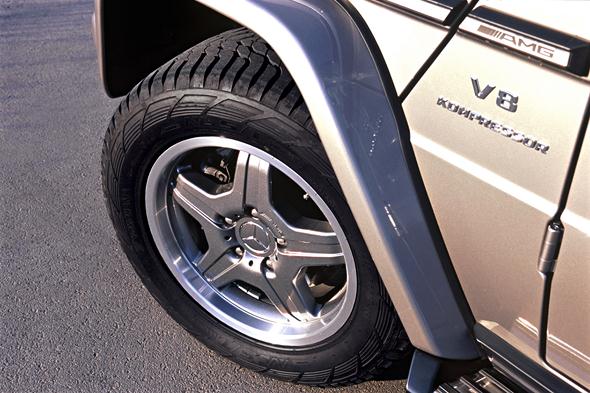
Both on and off-road, the G 55 AMG gives its occupants a feeling of serenity, exclusivity and dynamic potential. As always, the classic among Mercedes-Benz off-roaders provides a convincing synthesis of highly efficient drive and dynamic handling control systems.

In addition to permanent all-wheel drive with a low-range gearbox, the standard appointments include the electronic traction system for all-wheel drive 4ETS, the Electronic Stability Program ESP® and differential locks which can be engaged at the touch of a button.
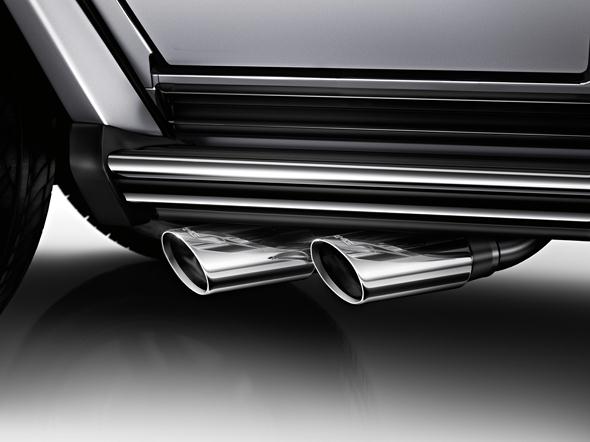
Magna Steyr inGraz,Austria, has been producing the G-Class on behalf of Mercedes-Benz since 1979, with more than 186,000 examples built to date. And there is no end to this success story in sight.
Enhanced standard appointments with AMG light-alloy wheels in titanium grey
Visually, the new model year G 55 AMG is distinguishable from its predecessor by 18-inch AMG light-alloy wheels painted in titanium grey with 285/55 R 18 wide-base tyres.
The extensive standard appointments have been further enhanced, now including bi-xenon headlamps, oval foglamps with a cornering light function and ISOFIX child seat attachments in the second seat row.
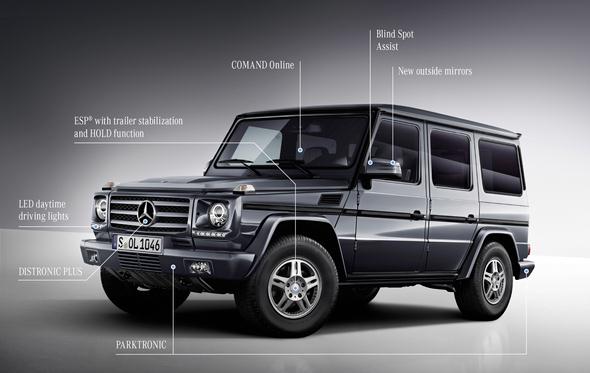
The more scratch resistant, nano-technology based paint finishes of calcite white, periclase green metallic and teallite blue metallic are also new.
The top-of-the-line model in the G-Class is available only as a five-door Station Wagon with a long wheelbase, and may be ordered in Mercedes-Benz sales outlets with immediate effect.
The selling price is (incl. 16% VAT), and customer deliveries will commence in September 2006.
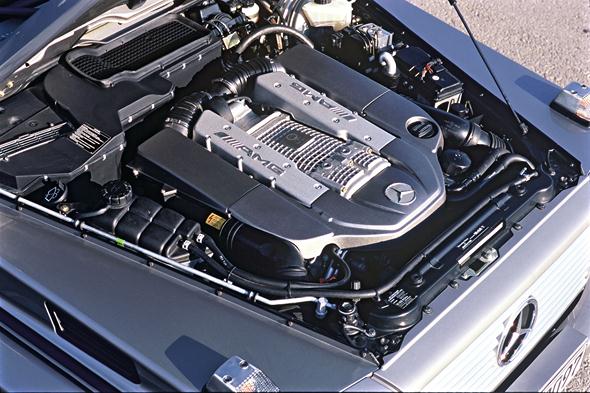
In addition to the classic G 55 AMG Kompressor, the Mercedes-AMG model lineup features two other powerful and versatile all-rounders: the new ML 63 AMG and
R 63 AMG, both equipped with the 378 kW/510 hp, naturally aspirated 6.3-litre AMG V8-engine.
G 63 AMG 6×6 near-series show vehicle
Taking the desert by storm
Stuttgart 2013. Superior 6×6 all-wheel drive technology, AMG V8 biturbo power and looks that leave no room for any doubt: the Mercedes-Benz G 63 AMG 6×6 near-series show vehicle is an off-roader which represents the last word in forward-thrusting power far from the beaten track.

400 kW (544 hp), a 6×6 drive, low-range ratio, five differential locks, portal axles, tyre pressure control system and a special chassis allow this pickup to make good progress in environments where the concept of individual mobility normally bites the dust as soon as the road ends.
But anyone who imagines that this is a Dakar-Rally-style vehicle is on the wrong track.
Thanks to the wealth of interior enhancements from the AMG stable, the occupants can enjoy the highest possible degree of comfort, even when negotiating the worst that the combined forces of topography and meteorology can throw at them.
The exclusive touches even extend to the load area which is finished in solid bamboo.
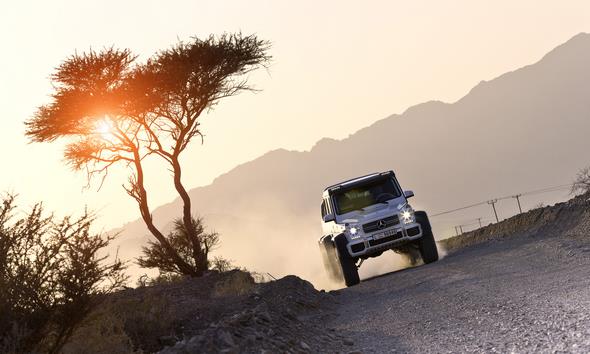
The Mercedes-Benz G 63 AMG 6×6 near-series show vehicle brings together the best of three worlds. The latest, revised G-Class series-production models lend the superior off-roader the effortless superiority and refinement of a vehicle which has dominated the off-road scene for 34 years.
They are also the source of the up-to-date interior concept with the contemporary dashboard featuring impressive new instruments and a large, central colour display.
Unreserved robustness as well as practicality and a can-do attitude to off-road driving are the traits inherited from the military and the commercial G-Class models.
Finally, the renowned Mercedes-AMG luxury and performance division contributes the superior engine technology and the interior which is as luxurious as it is comfortable.
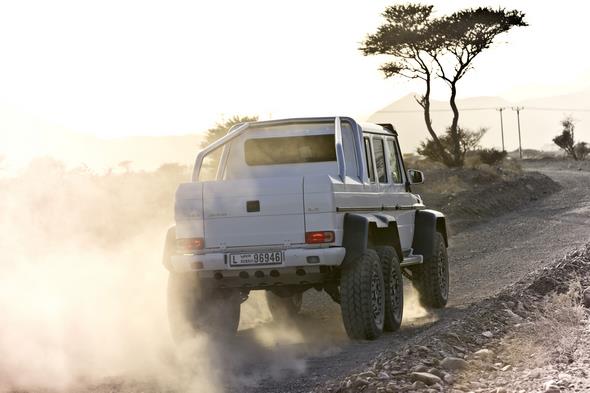
6×6 technology: to the ends of the earth – and beyond
A look at the key data of the G 63 AMG 6×6 makes it clear that this model’s off-road world begins at a point where anything less than a vehicle with caterpillar tracks would have to capitulate.
Six driven wheels, an off-road low-range ratio in the transfer case, portal axles, five differential locks which can be engaged on the move and a tyre-pressure control system which allows the pressure in the huge 37-inch tyres to be adjusted in record time while the vehicle is running – all these are features which one seeks in vain in conventional cross-country vehicles.

Together, they ensure that the G 63 AMG 6×6 has driving dynamics which are more than a match for the toughest terrain. As a result, the show vehicle is able to storm up the highest sand dunes with ease while sand tracks hold no fears thanks to its unshakable directional stability.

Rocky terrain is negotiated with all the agility of a mountain goat; fording a river becomes almost child’s play thanks to the impressive fording capability of one metre.

And anyone exploring the on-road performance is certain to be impressed by the catapult-like acceleration of this 3.85-tonne pickup.

Despite its unique drive technology, the show vehicle does not actually represent a new development in terms of technology.

After 34 years of G-Class production, there is such a large array of “G” parts to draw on that the G 63 AMG 6×6 uses almost exclusively series-production components under the skin.

A case in point is the drive train: the AMG V8 biturbo engine with 400 kW (544 hp) and 760 newton metres of torque, the AMG SPEEDSHIFT PLUS 7G-TRONIC automatic transmission paired with the front drive system from the G 63 AMG and a rear twin drive train from the 6×6 version which has already proven its reliability in service with users such as the Australian army.
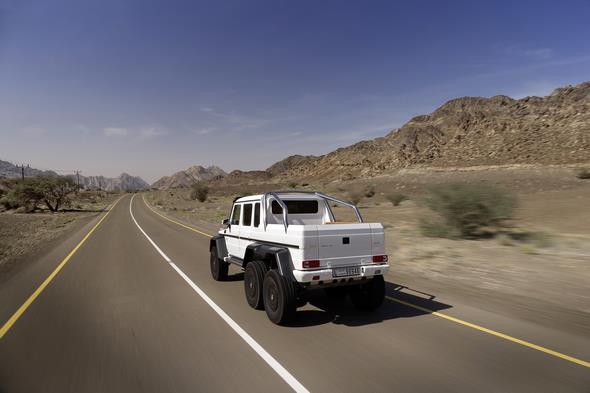
Plus the ingenious portal axles, which also have military origins, here making their debut in a civilian vehicle.
Independent and neutral: the chassis
The chassis is largely based on the current production configuration, the only difference being that the helical springs and dampers have been adjusted to take account of the changed characteristics of the three-axle model.
For the springs, too, the engineers were able to draw on the comprehensive array of “G” parts, which includes no less than 15 different spring rates.

While the front axle takes over the reinforced springs from an armoured special-protection variant, the first rear axle has been given a significantly harder spring rate and the second rear axle a softer one.
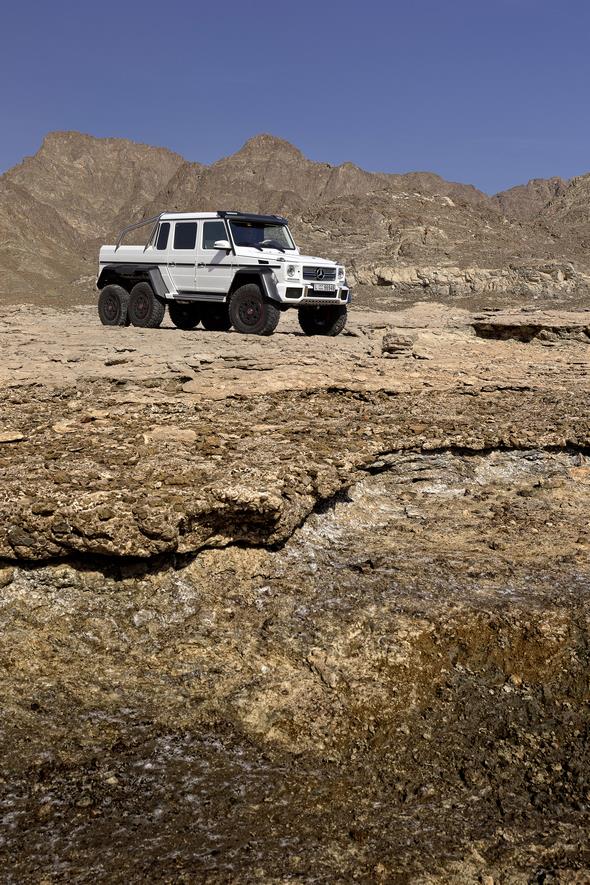
This set-up, together with the rally-proven, adjustable gas-pressure shock absorbers, results in a perfect symbiosis of sporty dynamism and composed comfort, on or off the road.

Macho outside – S-Class inside
Visually, the G 63 AMG 6×6 pickup leaves no room for any doubt as to its true calling. The large tyres on the three axles, the huge ground clearance, the height of almost 2.30 metres and the width of some 2.10 metres as well as the clean-cut lines of the pickup immediately inspire respect.

Like the G 63 AMG and G 65 AMG models before it, the super off-roader with its 5.87-metre-long body has the characteristic AMG brand face with the “twin blade” radiator grille.
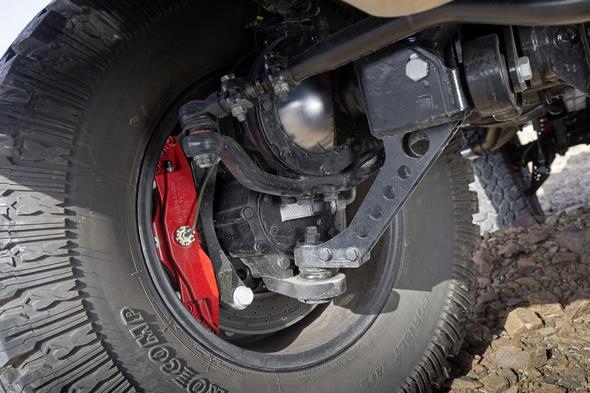
Other visual highlights include the use of elegant carbon fibre for the integrated LED light strips above the windscreen as well as for the large flared wheel arches while the rear load area section has a distinctive stainless-steel roll-over bar.
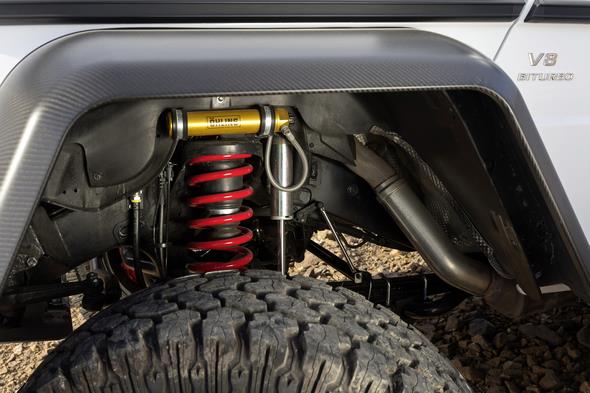
The load area, which is lined with particularly tough and durable bamboo, can be accessed by means of a tailboard.
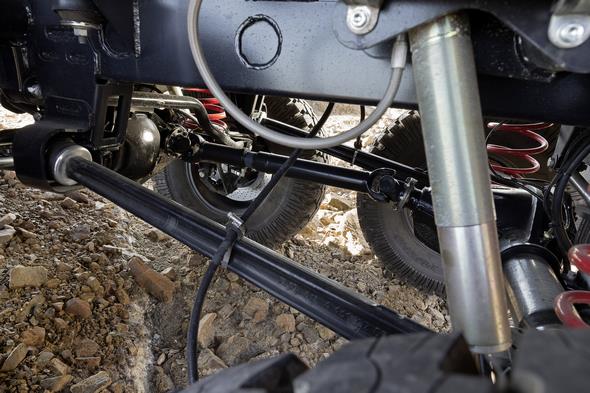
Sporty luxury, the hallmark of AMG, is the defining characteristic of the interior. The G 63 AMG 6×6 welcomes its occupants aboard with an exclusive ambience of classic red or light brown designo leather with contrasting topstitching and attractive diamond-pattern quilting.
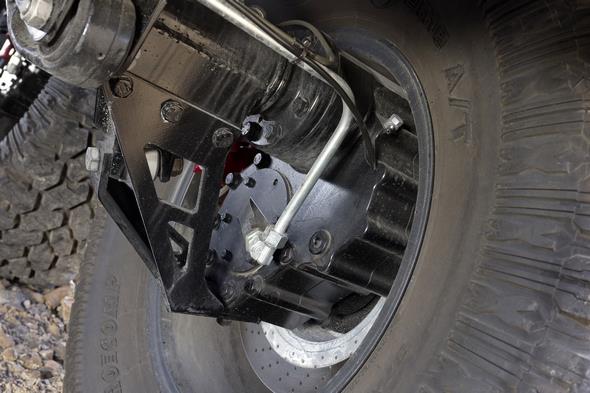
The four electrically adjustable individual seats are heated and ventilated. The rear compartment is equipped with a special centre console while the roof liner and pillars are finished in an Alcantara® covering. The rear panel is trimmed in leather.
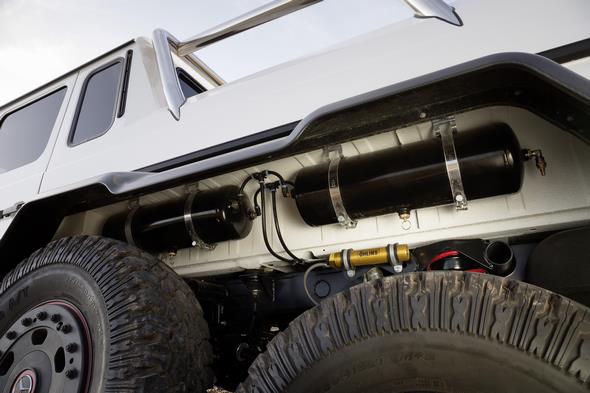
Graz is the centre of the “G” world
The two G 63 AMG 6×6 vehicles which have been built to date were developed with Mercedes-Benz at the helm. The Graz-based Mercedes-Benz G-Class development department is the centre of competence for all “G” projects and is responsible for development and series support of the legendary cross-country vehicle.
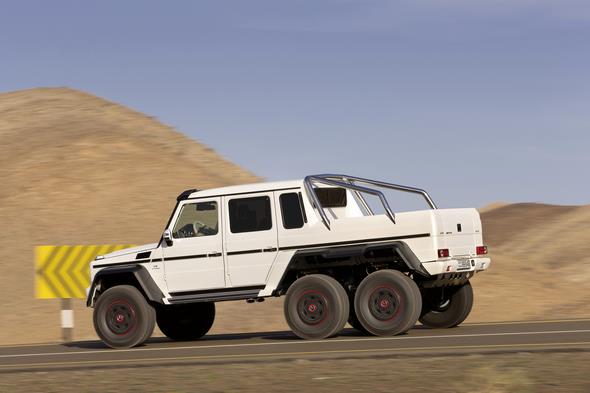
Furthermore, Graz in Austria has been the production site for all civilian and commercial G-Class vehicles since 1979. The response to the near-series show vehicle will determine if and when the Mercedes-Benz G 63 AMG 6×6 enters small-series production.
Ideal partnership: Off-road high-performance technology and AMG power
- Innovative 6×6 drive with central through-drive axle
- Huge ground clearance and fording depth thanks to portal axles
- Total of five 100% differential locks
- Massive pulling power from AMG 5.5-litre V8 biturbo engine
- Short shift times with AMG SPEEDSHIFT PLUS 7G-TRONIC
A look at the key data of the G 63 AMG 6×6 makes it clear that this model’s off-road world begins at a point where anything less than a vehicle with caterpillar tracks would have to capitulate.

Six driven wheels, an off-road low-range ratio in the transfer case, portal axles and five differential locks which can be engaged on the move are features which one seeks in vain in conventional off-road vehicles.

Together, they ensure that the G 63 AMG 6×6 has driving dynamics which are more than a match for the toughest terrain. As a result, the show vehicle is able to storm up the highest sand dunes with ease while sand tracks hold no fears thanks to its unshakable directional stability.

Rocky terrain is negotiated with all the agility of a mountain goat; fording a river becomes almost child’s play thanks to the impressive fording capability. And anyone exploring the on-road performance is certain to be impressed by the catapult-like acceleration of this 3.85-tonne pickup.

Despite its unique drive technology, the show vehicle does not actually represent a new development in terms of technology.

After 34 years of G-Class production, there is such a large array of “G” parts to draw on that the G 63 AMG 6×6 uses almost exclusively series-production components under the skin.

A case in point is the drive train: the AMG V8 engine, the AMG SPEEDSHIFT PLUS 7G-TRONIC automatic transmission and the front drive system have been taken over from the G 63 AMG while the transfer case with low-range ratio has been matched with a rear twin drive train from a 6×6 version which has already proven its reliability in service with users such as the Australian army.
Technical highlight: the portal axles
Newly developed for a wide variety of applications, the portal axles which have been added to the Mercedes-Benz off-road portfolio are the real technical highlight of the show vehicle.
Unlike conventional rigid axles, where the wheels are centred on the axis of the shaft, the wheels of the portal axle are significantly lower thanks to the portal gears on the axle heads.
As a result, the ground clearance of the G 63 AMG 6×6 is increased to 460 millimetres (series-production G-Class: 210 millimetres) and the fording depth – or maybe it would be more accurate to say diving depth – is increased to 1000 millimetres (series-production: 600 millimetres).

This design has further important benefits which do away with the need for elaborate adaptation measures.
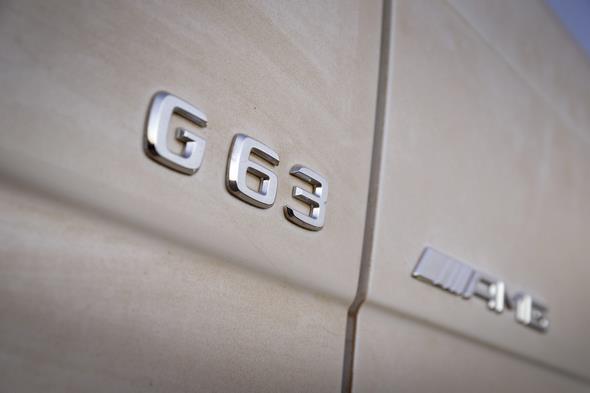
As the position of the axles relative to the chassis remains unchanged, so too do the suspension anchorage points, the steering connection and the position of the propshafts.
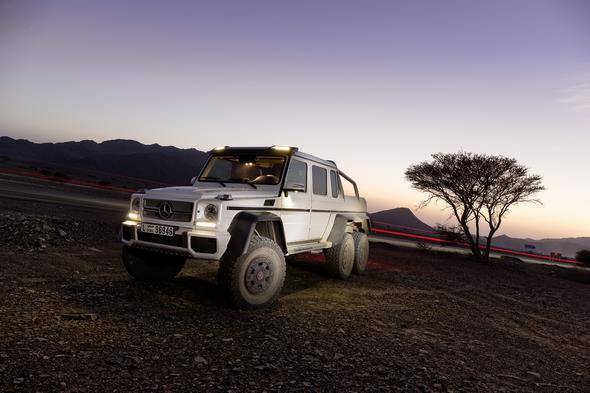
Furthermore, the portal gear reduction ratio compensates for the huge rolling circumference of the 37-inch tyres so that the gear ratios, speedometer drive and ABS sensors also remain unchanged.

An additional benefit of the reduction ratio applied by the portal gears is that the drive torque is only applied to the wheels themselves with the result that the mechanical loads on the drive train – especially the drive shafts – are reduced.

Through-drive: the centre differential
A technically sophisticated solution provides the 6×6 drive system with the necessary through-drive through the differential of the first rear axle to the rear one.

The arrangement which has been developed is extremely compact and requires little more space than a conventional differential housing.

An extra shaft with an integrated lock situated on the side above the differential takes the drive torque to the rear axle. A chain provides the necessary power take-off for the differential of the first rear axle.
Precisely coordinated logic governs operation of five differential locks
With a total of five mechanical 100-percent differential locks available, drivers would certainly lose track of the settings now and again if they could be engaged separately.

This is why the engineers have developed a special locking logic which ensures the best possible traction is available in every situation.

The whole system is controlled electrically with the usual three differential lock switches in the centre console which are to be found in all G models. Preselected and engaged locks are indicated by yellow and red lights respectively.
- Stage 1: the two inter-axle differential locks in the transfer case and in the through-drive through the centre differential are active
- Stage 2: the interwheel differential locks in the two rear axle differentials are additionally activated
- Stage 3: with the front axle differential locked, all five differential locks are now active
All lock stages can be selected regardless of whether the low-range ratio in the transfer case is selected.
It is clear that, with a wheelbase of some 4.20 metres, the G 63 AMG 6×6 is not predestined for virtuoso cornering.
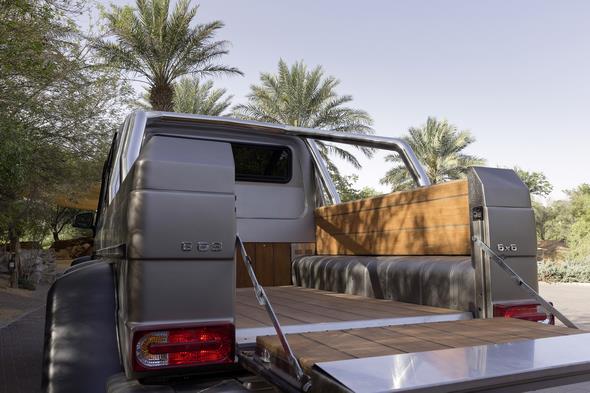
Nevertheless, in order to ensure impressive agility with corresponding dynamism about the vertical axis of the vehicle, the engineers have varied the torque distribution.
The drive torque is therefore split 30 to 40 to 30 percent between the front axle and the two rear axles.

V8 biturbo from power specialists Mercedes AMG
Much of the credit for the superior performance of the G 63 AMG 6×6 is due to the AMG V8 engine and the AMG SPEEDSHIFT PLUS 7G-TRONIC automatic transmission.

The AMG 5.5-litre V8 biturbo engine develops a peak output of 400 kW (544 hp) and 760 newton metres of torque. Known in-house by the designation M 157, the engine impresses with its technological highlights.

The greater thermodynamic efficiency which results from the combination of twin turbochargers, direct petrol injection and spray-guided combustion allows better fuel economy and leads to lower exhaust emissions.

Fast and precise piezo-electric injectors spray the fuel into the combustion chambers, ensuring a particularly fine distribution throughout the air in the combustion chamber.

An electric low-pressure pump delivers the fuel from the tank to a high-pressure pump in the engine compartment at a pressure of six bar.

The fuel pressure in the high-pressure rail is controlled between 100 and 200 bar on a fully variable and demand-related basis, ensuring an agile response in any driving situation.

Further highlights of the innovative and unique eight-cylinder powerplant from AMG in Affalterbach include an all-aluminium crankcase, four valves per cylinder with camshaft adjustment, air/water intercooling and alternator management.

Any doubts about the show vehicle’s ability to speak directly to the emotions are quickly dispelled by a look at the AMG sports exhaust system: twin tailpipes ahead of the rear wheels on both sides put out the hallmark AMG eight-cylinder sound.
Faster shifting with the AMG SPEEDSHIFT PLUS 7G-TRONIC
Featuring three drive modes and an automatic double-declutching function for downshifting, the AMG SPEEDSHIFT PLUS 7G-TRONIC automatic transmission delivers the drive to the transfer case with low-range ratio by means of a propshaft.

“Controlled Efficiency” (C) mode calls up engine and drive control strategies designed to deliver a driving style which is as economical as possible. In the Sport (S) and Manual (M) driving modes, the engine-transmission combination displays considerably greater agility.

Here, a brief and exactly defined retardation of ignition and injection during upshifting at full load provides for shorter shift times.

Furthermore, in “M” mode, the G 63 AMG 6×6 maintains the gear selected by the driver to the extent that this is permitted by the engine rev limits – a particularly useful feature when negotiating challenging climbs.

The efficiency of the AMG SPEEDSHIFT PLUS 7G-TRONIC automatic transmission system is further enhanced with a new fuel economy converter with centrifugal pendulum, friction-reducing bearings and transmission oil thermal management.

It makes sense to provide an ample fuel supply for vehicles which are designed to be used in remote areas. This is why the standard production tank with a capacity of 96 litres has been complemented by a 63-litre auxiliary tank.

The total tank capacity therefore amounts to 159 litres.

Chassis and wheels
Automotive declaration of independence
- Axle and suspension components from the G range
- Rally-proven, adjustable gas-pressure shock absorbers
- Best possible degree of articulation
- Three-part stainless-steel underguard
- Tyre pressure control system controllable on the move
- Tyre pressure can be set to required level in record time
- Special beadlock wheels for demanding off-road use
As already described, the chassis is largely based on the current production configuration, the only difference being that the helical springs and dampers have been adjusted to take account of the changed characteristics of the three-axle model.
For the springs, too, the engineers were able to draw on the comprehensive array of “G” parts, which includes no less than 15 different spring rates.

Both the front axle and the first rear axle have substantially harder springs from the special-protection variant while the second rear axle has a softer spring rate.
With all three rigid axles able to move independently, the G 63 AMG 6×6 has independent axle suspension rather than independent wheel suspension.
The axles articulate independently of each other, thereby ensuring the best possible frictional connection with the ground at all times.

Although the two rear axles are only 1100 millimetres apart (the overall wheelbase is 4220 millimetres), they are able to assume dramatically opposing articulation angles and so make effective use of every opportunity to gain traction, even in extremely rough terrain.

Only a “G” can improve on a “G”
The adjustable and rally-proven gas-pressure shock absorbers are supplied by an external partner. Working in concert with the voluminous tyres, the chassis set-up impresses with its outstanding ride comfort combined with high driving dynamics and driving safety under all conditions, on and off the road.

The suitability of the G 63 AMG 6×6 for off-road use becomes particularly clear when its key off-road data* are compared with those of the already impressive series-production G:
| G 63 AMG 6×6 | G 500 Long Station Wagon | |
| Ground clearance | 460 mm | 210 mm |
| Angle of approach/departure | 52°/54° | 36°/27° |
| Breakover angle | 22° | 21° |
| Tilt angle | 30° (58%) | 28° (54%) |
| Fording depth | 1000 mm | 600 mm |
| Slope climbing ability | 100% | 100% |
*Max. figures in ready-to-drive condition acc. to EC: Standard equipment including driver (68 kg), luggage (7 kg) and fuel tank 90% full.
If, despite all the driver’s efforts and the outstanding ground clearance, the chassis should accidentally come into contact with the ground, the developers have had the foresight to equip the vehicle with a robust, three-part underguard in stainless steel.
This ensures that the most important assemblies at the front and rear as well as those in the underbody area between the front and rear axles are well protected from impacts and hefty knocks.

“…and major variations in air pressure are expected to occur rapidly…”
The design of the tyre pressure control system is in keeping with the high technical standard of the G 63 AMG 6×6. A system that is a familiar feature of many trucks is being used in a passenger car for the first time.
From inside the vehicle, it is possible for the driver to adjust the tyre pressure on the front axle and both rear axles independently at any time by means of switches on a special overhead console.
Pressure gauges allow the pressures to be monitored. This means that the occupants are spared the usual laborious process of getting out and adjusting the pressures manually.

Thanks to a powerful compressor and four 20-litre compressed air reservoirs fitted at the sides in the rear wheel arches, the tyre pressure can be adjusted in possibly world-record time.
For example, although there are six voluminous tyres with a diameter of one metre each, it takes the system under 20 seconds to increase the sand-friendly tyre pressure of 0.5 bar to the 1.8 bar required for on-road use.
Conventional systems take around ten minutes to achieve such a change in tyre pressure.
The design of the portal axles also has a very positive effect where the tyre pressure control system is concerned. Unlike the situation found where conventional rigid axles are fitted, the inner faces of the wheel hubs are exposed and the installation space is not blocked by the drive shaft.
This means that the tyre pressure adjustment can be carried out directly by means of a central channel in the wheel hub.
The wheels also have an air channel and are connected to the hub via a compressed air hose with a quick-release coupling to enable a wheel change, if necessary. A strong, bolted hub cover protects the hose connector from damage in off-road terrain.

Despite a kerb weight of 3850 kg: Ground pressure distribution as low as a human footprint
With the usual wheel/tyre combinations it is impossible to reduce the tyre pressure to 0.5 bar for driving in sand. 1.0 bar is normally the lowest possible pressure, below which tyres may come off their rims during steering manoeuvres and sand can enter the sealing surface between tyre and rim, resulting in a slow puncture.
There are no such problems with the G 63 AMG 6×6 which is equipped with special, two-part 45.7 cm (18-inch) beadlock wheels.
When a tyre is fitted to this type of wheel, it is clamped between the wheel (formed by the two halves of the rim) and an internal beadlock ring so securely that, even in the event of a complete loss of pressure, it cannot slip off the rim and sand cannot enter.

The extremely low tyre pressures increase the contact patches of the 37 x 12.5 x 18 inch all-terrain tyres and provide considerable support when it comes to making progress on loose surfaces.
Two processes contribute to this. First, the increased contact patches reduce the ground pressure and thus the tendency of the tyres to sink or dig into the ground.
A look at the figures brings this home: reducing the tyre pressure to 0.5 bar increases the contact patch threefold.
As a result, the ground pressure of the G 63 AMG 6×6 with a ready-to-drive kerb weight of 3850 kilograms is equal to that of the footprint of a person of average weight.
Second, on muddy and similar surfaces offering better contact, the low tyre pressure supports the self-cleaning process which prevents clogging of the tread pattern and so ensures that the best possible traction is always available.
Typical AMG: A full range of exclusive equipment and appointments
- Three-axle pickup body with a distinctive look
- Flared wheel arches in carbon fibre
- Rear load area with stainless-steel roll-over bar
- Four electrically adjustable, heated and ventilated individual seats
- Fully appointed in exclusive designo leather
Visually, the G 63 AMG 6×6 leaves no room for any doubt as to its true calling. The large tyres on the three axles, the huge ground clearance, the inside height of almost 2.30 metres and the width of some 2.10 metres as well as the clean-cut lines of the pickup immediately inspire respect.

Like the G 63 AMG and G 65 AMG models before it, the super off-roader with its 5.87-metre-long body has the characteristic AMG brand face: the “twin blade” radiator grille with its chrome-plated twin louvre and chrome-plated grille ensure that, like its series-production stablemates, the G 63 AMG 6×6 is immediately identifiable as an AMG model.
The design of the grille takes account of the classic G-Class form and fits into the overall look with its interpretation of the off-road character of the vehicle.
The typical three large air intakes in the front AMG bumper allow the airflow to reach the cooling modules. Vertical stainless-steel inserts in high-gloss chrome underline the masculine look.

The side view shows that, up to the two rear doors, the body corresponds to the current production configuration of the four-wheel model.
But that is as far as the common features go, as the side view also reveals the differences – from the significantly greater ride height to the carbon fibre of the integrated LED light strips above the windscreen to the flared wheel arches – also in carbon fibre – with the stainless-steel running boards.
The series-production part of the body is extended harmoniously by a third side window and the pickup section with the stainless-steel roll-over bar as well as the rear, twin flared wheel arches in carbon fibre.
The load area, which is lined with particularly tough and durable bamboo, can be accessed by means of a tailboard.
Off-road comfort with four individual seats
As well as featuring the series-production facelift measures, such as the new dashboard with the central colour screen, the G 63 AMG 6×6 offers an AMG instrument cluster with a colour TFT screen, the AMG main menu and a separate gear indicator as well as AMG door sill panels illuminated in white at all doors.
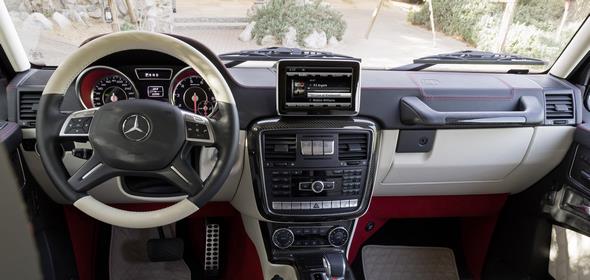
The high-quality E-SELECT lever with the embossed AMG emblem is familiar from vehicles such as the SLS AMG. An exclusive ambience is created by the designo leather appointments – in classic red or light brown – comprising not just the upholstery of the four individual seats, but also the entire lining of the front and rear doors.
Contrasting topstitching and attractive diamond-pattern quilting provide the perfect complement to the appointments. Furthermore, the entire dashboard is finished in leather and also features the exclusive contrasting topstitching.
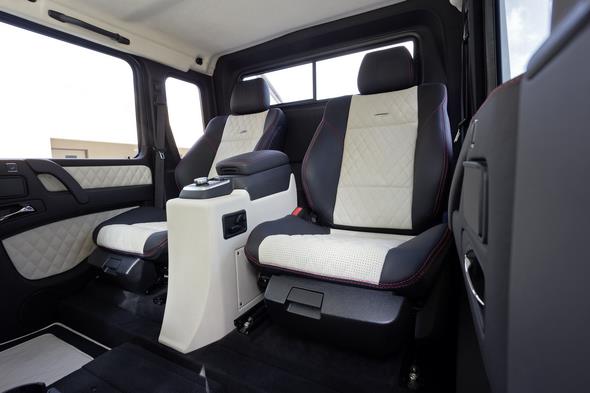
AMG carbon fibre trim and the Alcantara® covering on the roof liner and pillars complete the luxurious and welcoming interior. The rear panel is trimmed in leather.
In addition to the full array of characteristic AMG luxury features from the G 63 AMG 6×6 and the comprehensive designo leather appointments with four individual seats, the show vehicle is provided with a package of exclusive extras.
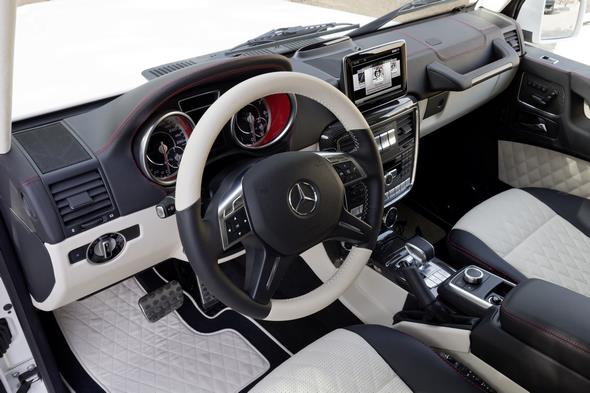
These include a set of special features for the rear of the occupant compartment: electrically adjustable, heated and ventilated individual seats, a separate centre console – also finished in designo leather with contrasting topstitching – and the Rear Seat Entertainment System with two colour screens on the back of the front head restraints.
Diamond-pattern floor mats complete the line-up.

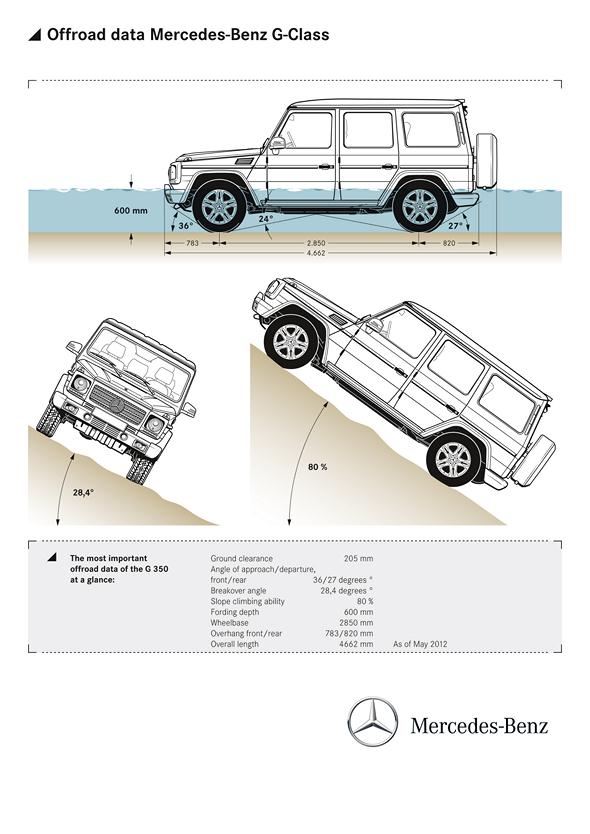
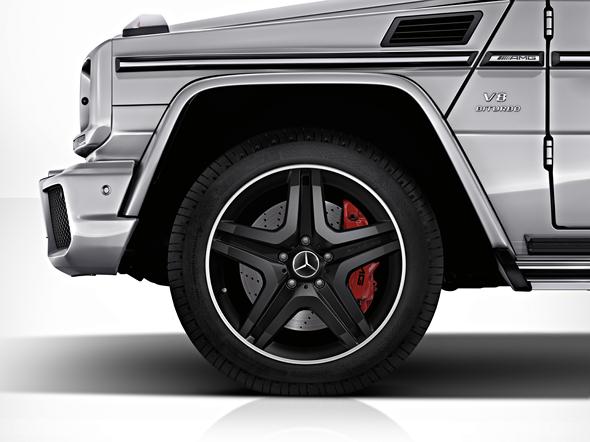


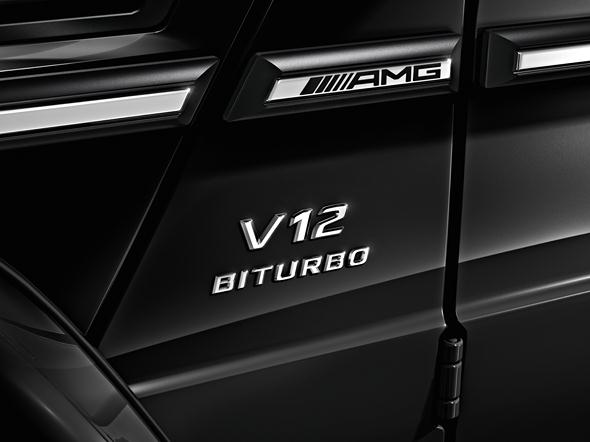
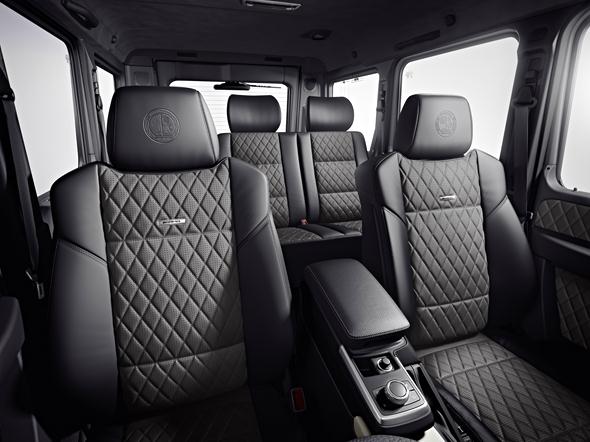
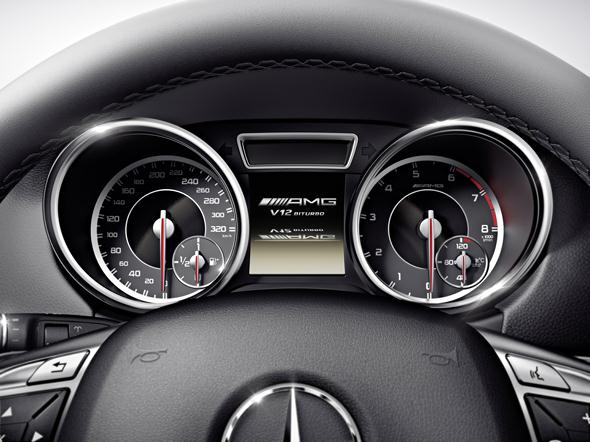

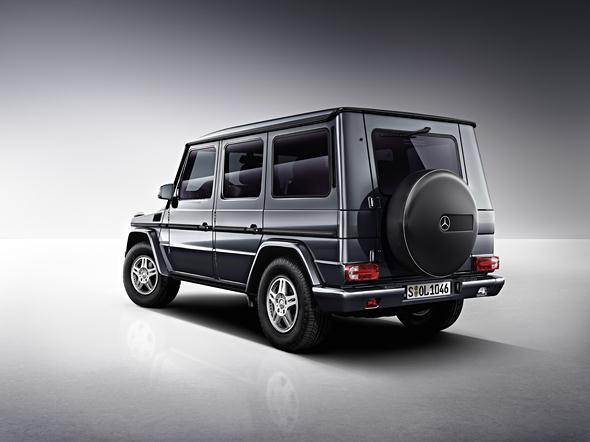


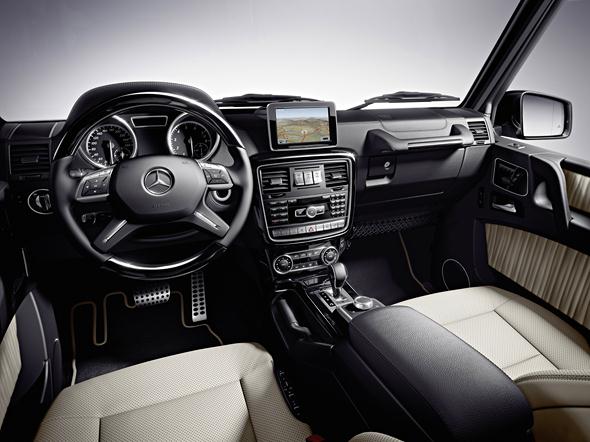

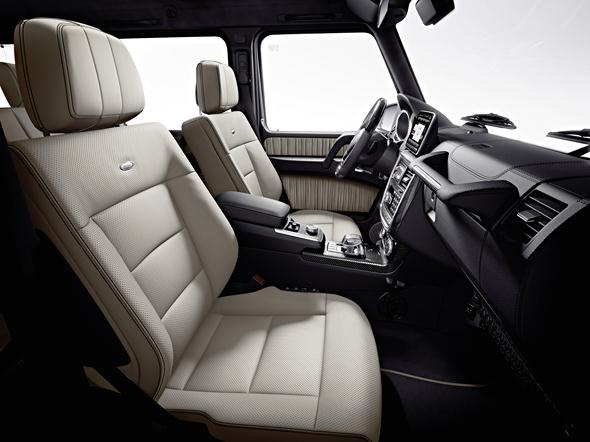

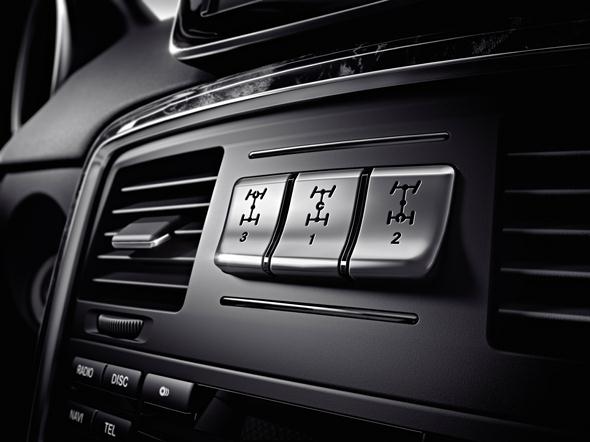
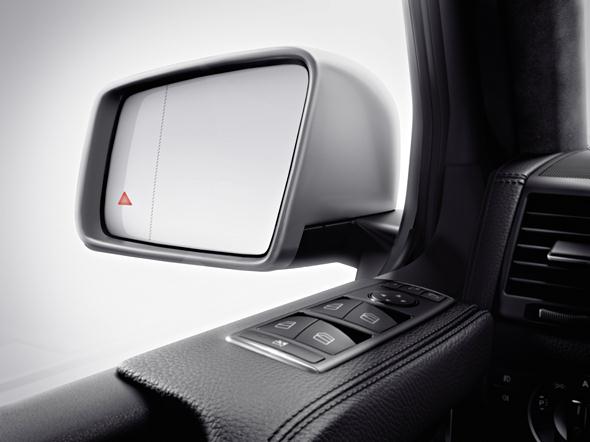
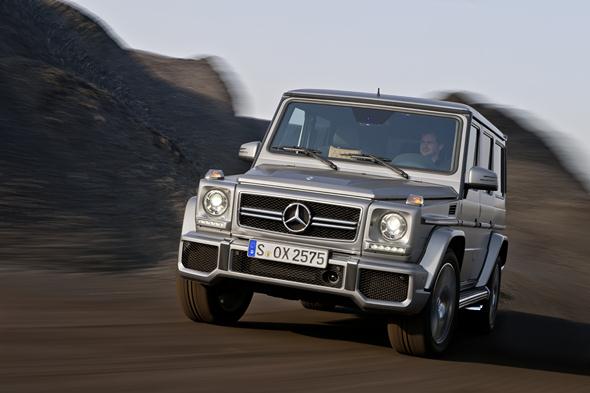
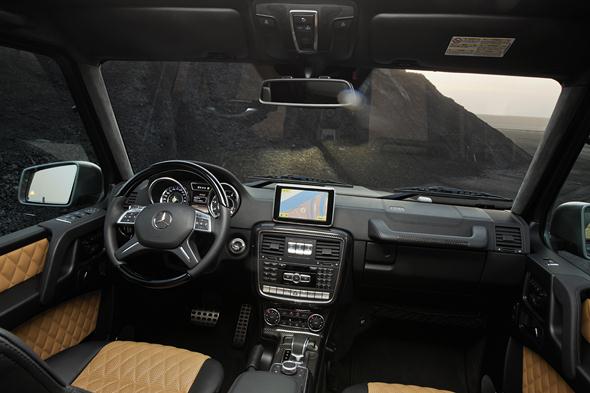
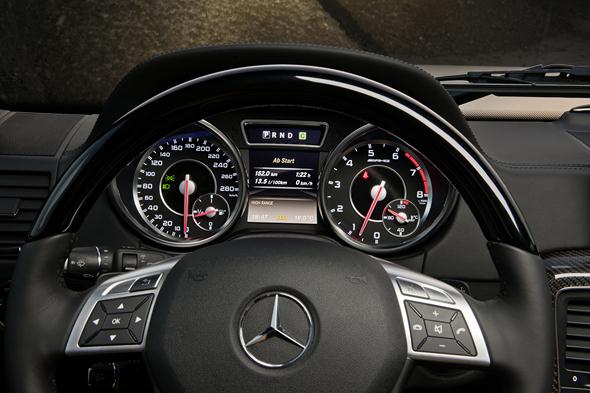

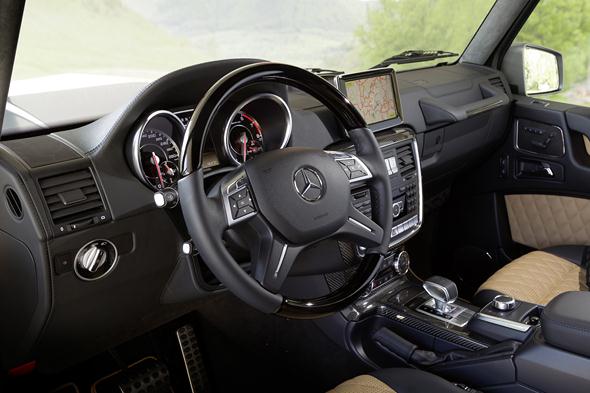
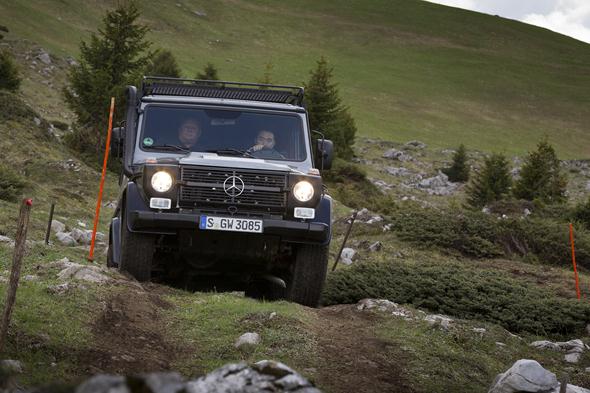
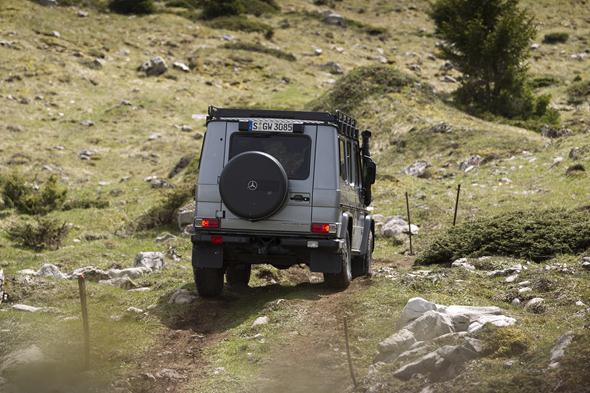
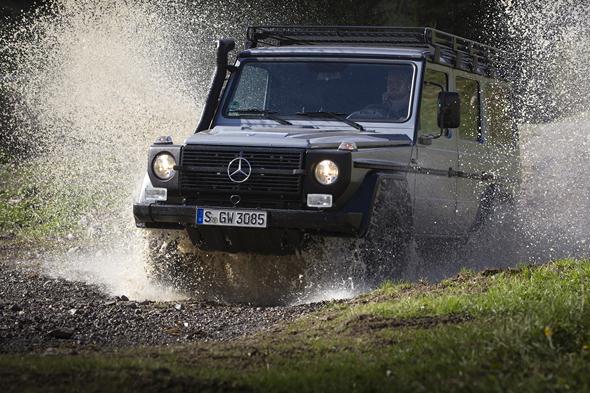


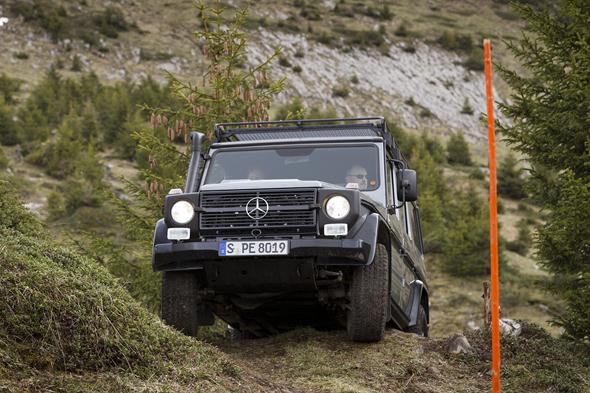
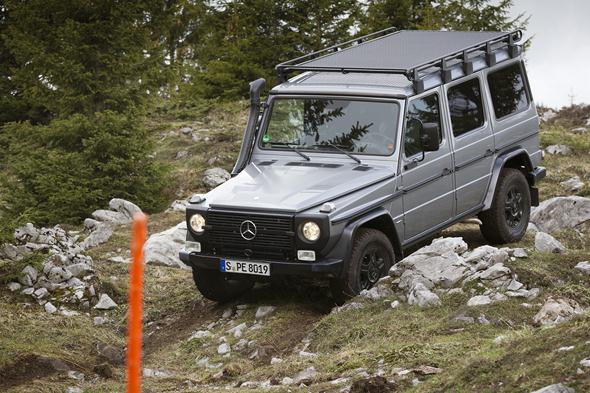
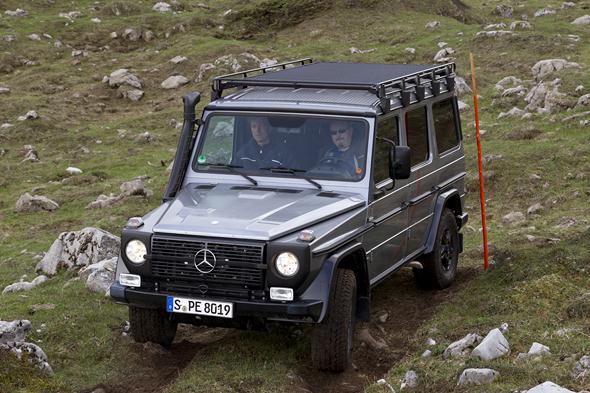
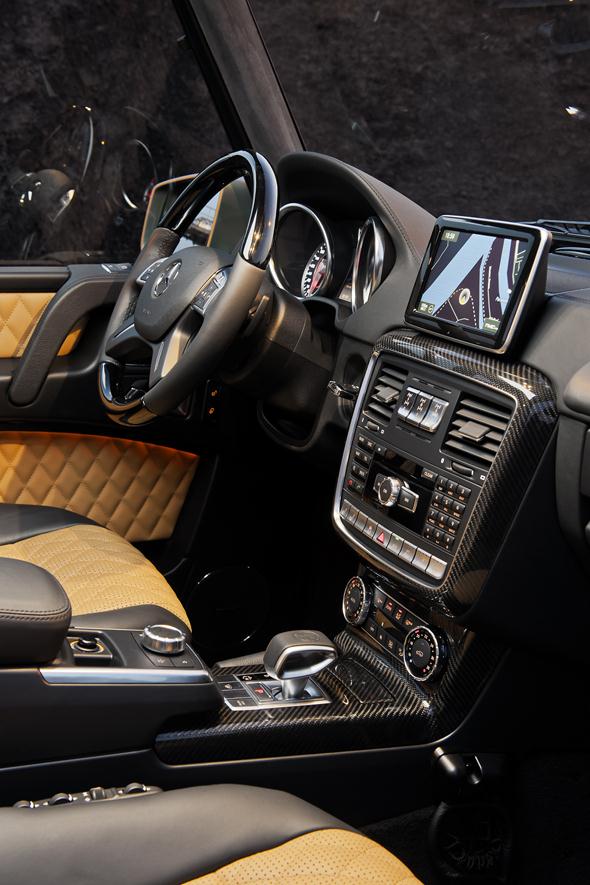

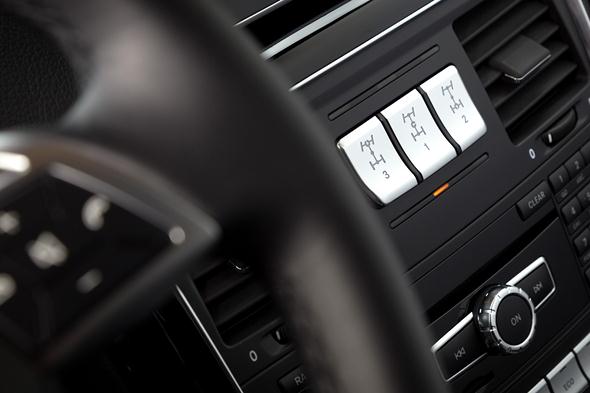



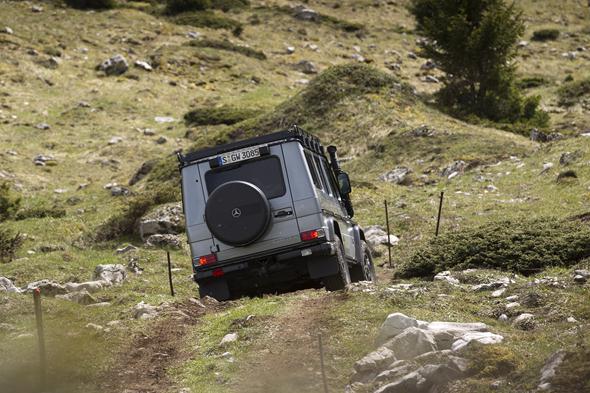
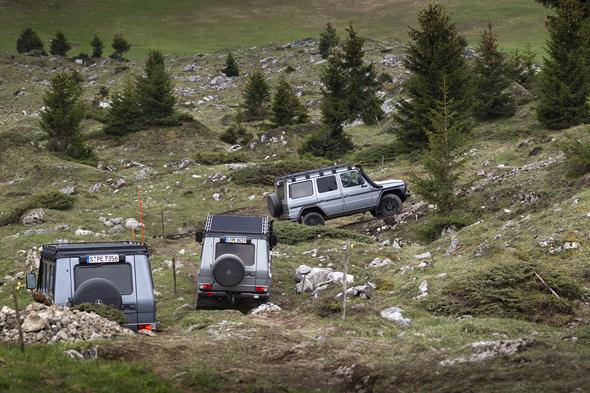
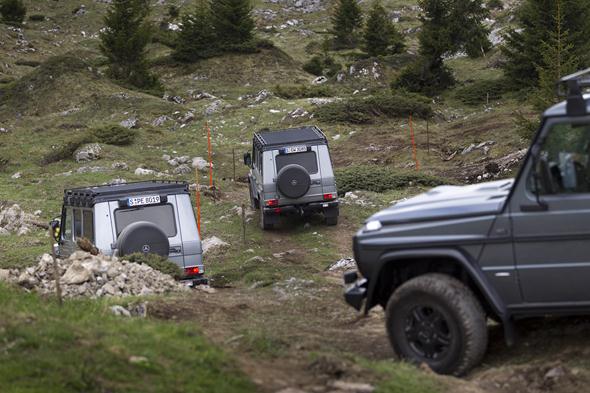

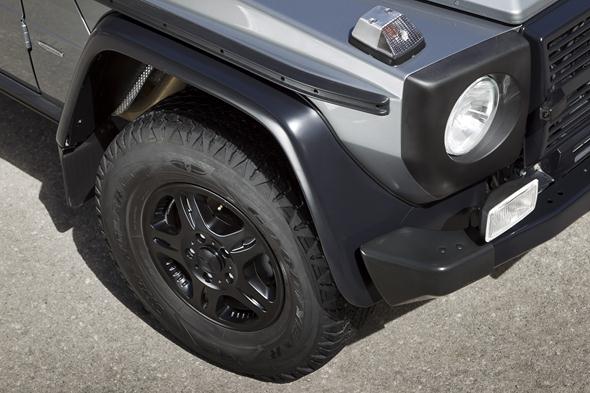
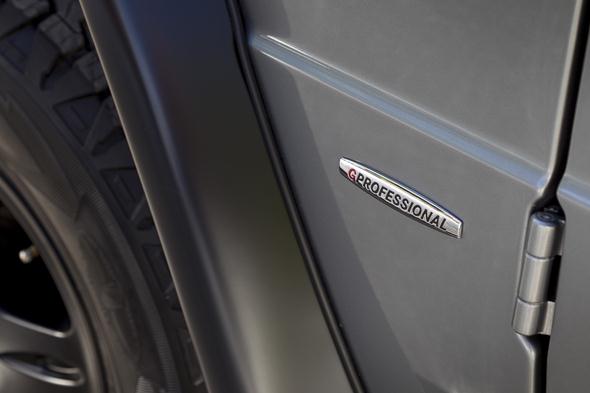
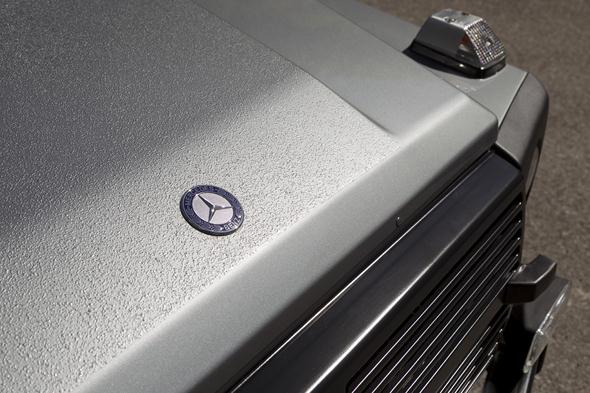
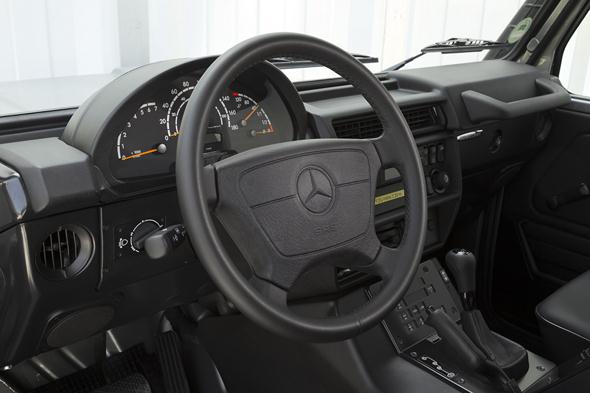
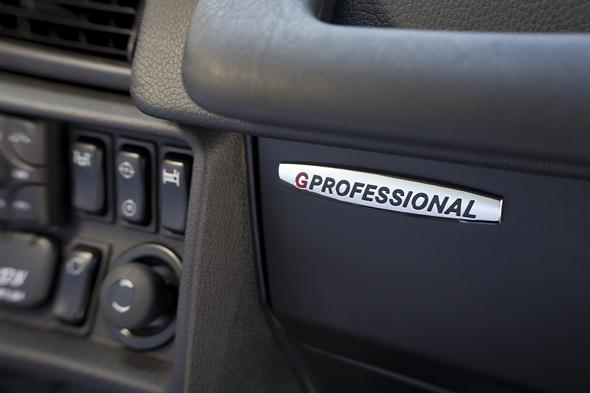
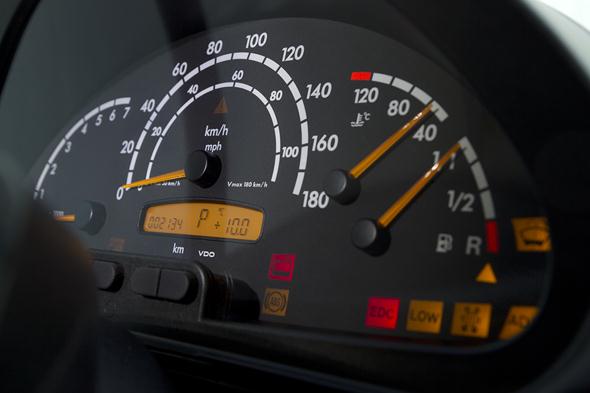
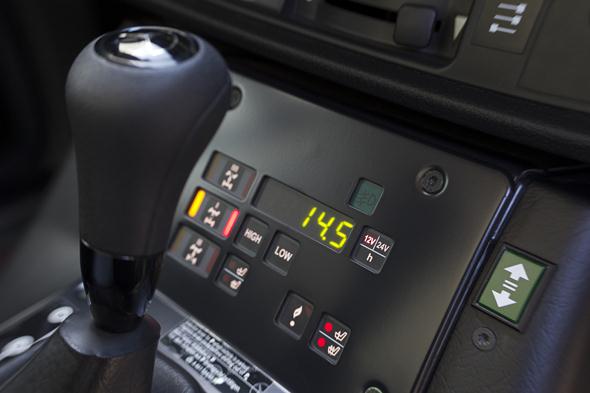
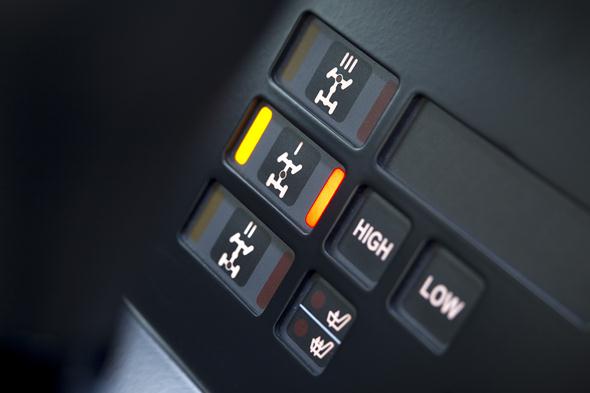
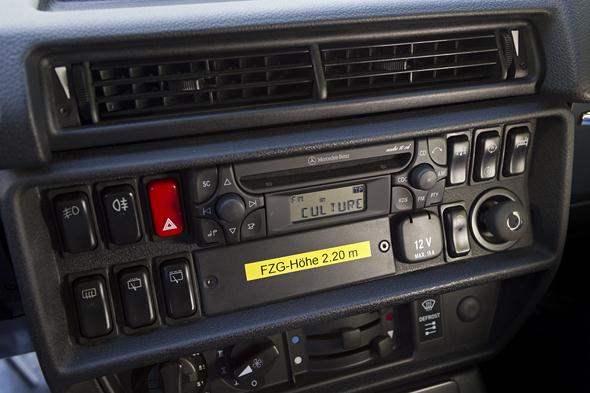
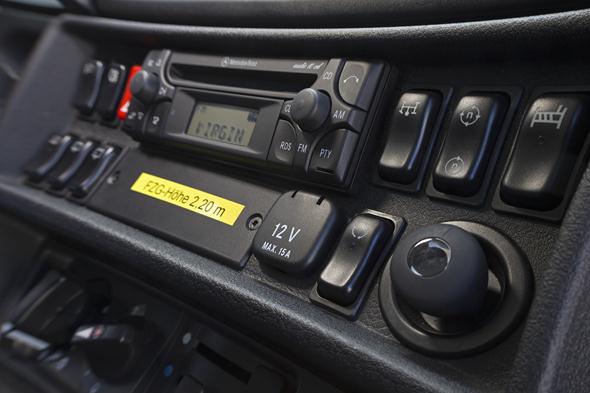
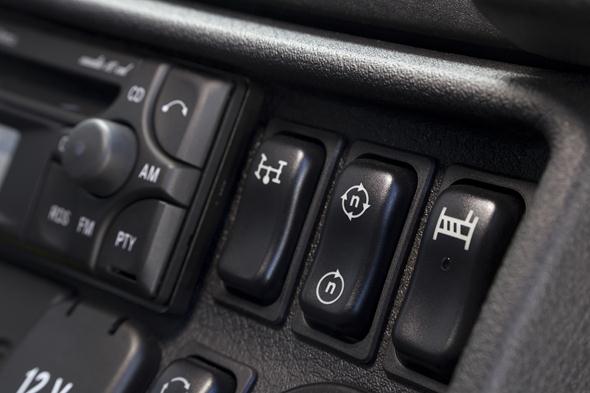
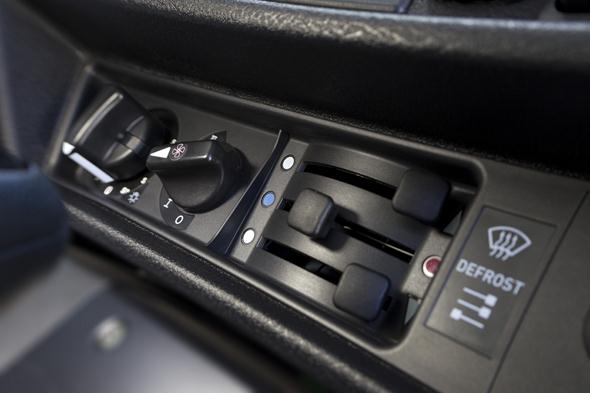






























































































![image3706[1] image3706[1]](/wp-content/gallery/w460/thumbs/thumbs_image3706%5B1%5D.jpg)
![image3707[1] image3707[1]](/wp-content/gallery/w460/thumbs/thumbs_image3707%5B1%5D.jpg)
![image3708[1] image3708[1]](/wp-content/gallery/w460/thumbs/thumbs_image3708%5B1%5D.jpg)
![image3709[1] image3709[1]](/wp-content/gallery/w460/thumbs/thumbs_image3709%5B1%5D.jpg)
![image3710[1] image3710[1]](/wp-content/gallery/w460/thumbs/thumbs_image3710%5B1%5D.jpg)
![image3711[1] image3711[1]](/wp-content/gallery/w460/thumbs/thumbs_image3711%5B1%5D.jpg)
![image3712[1] image3712[1]](/wp-content/gallery/w460/thumbs/thumbs_image3712%5B1%5D.jpg)
![image3713[1] image3713[1]](/wp-content/gallery/w460/thumbs/thumbs_image3713%5B1%5D.jpg)























































































































































